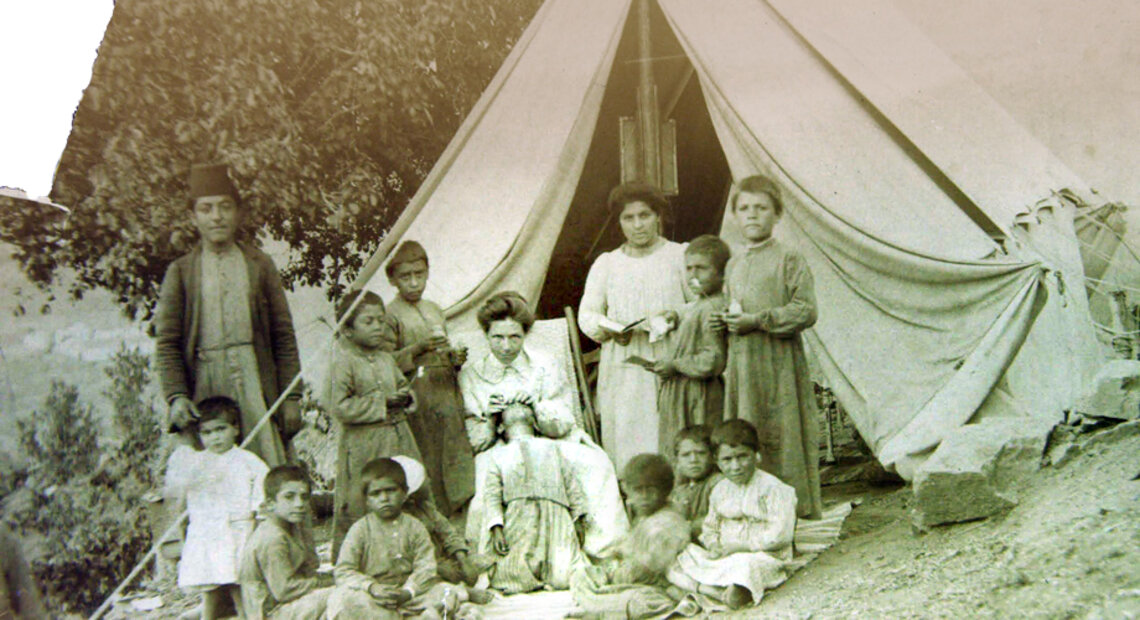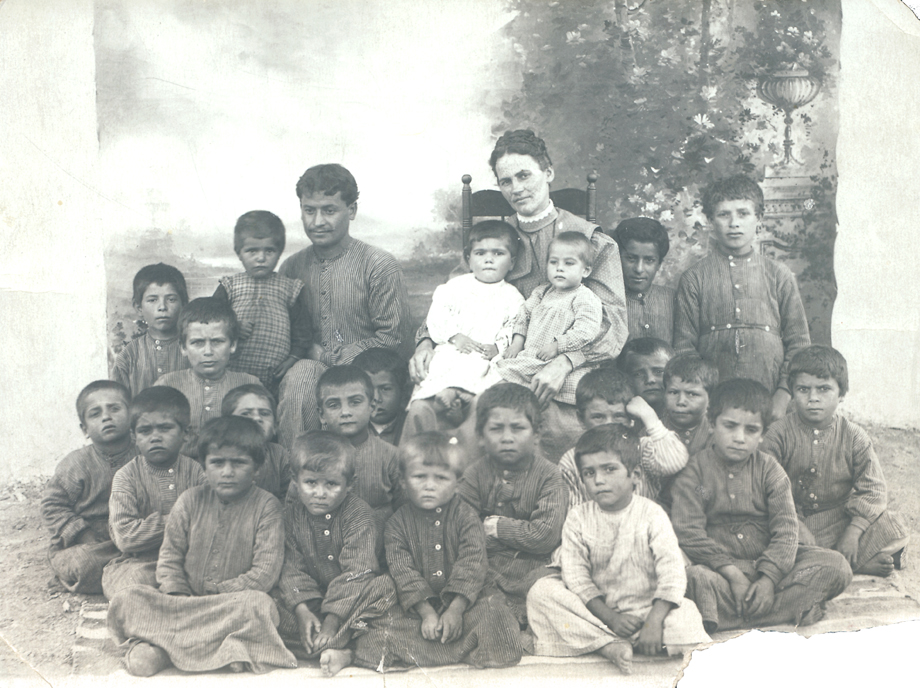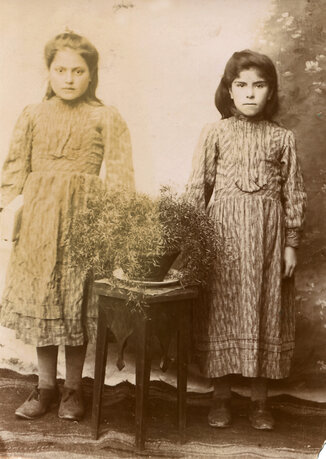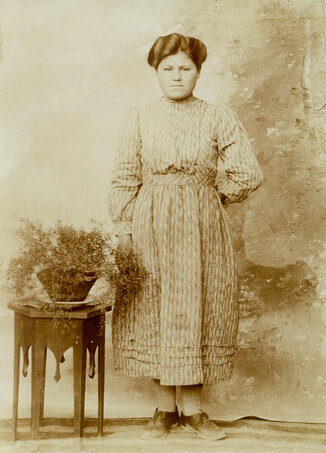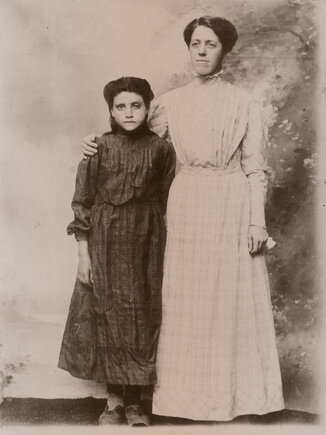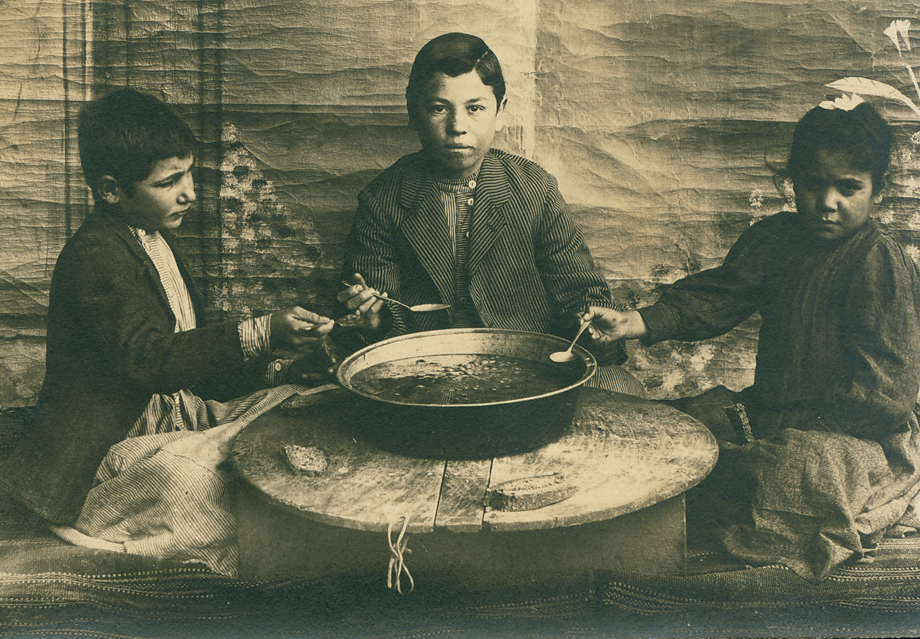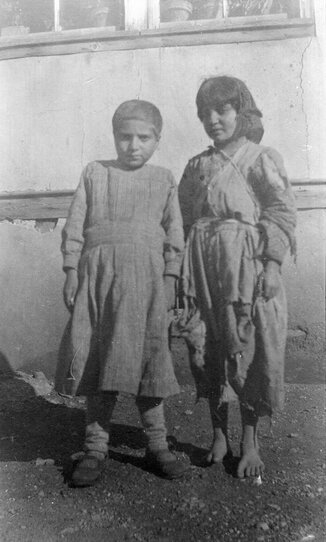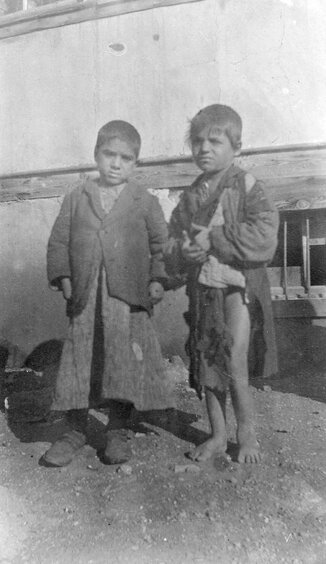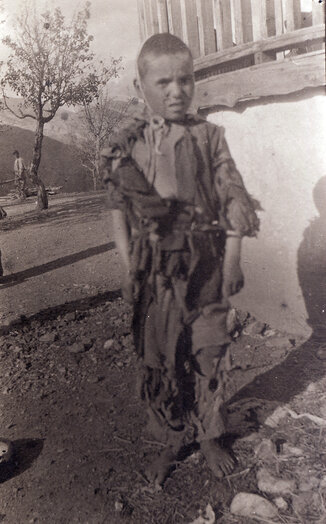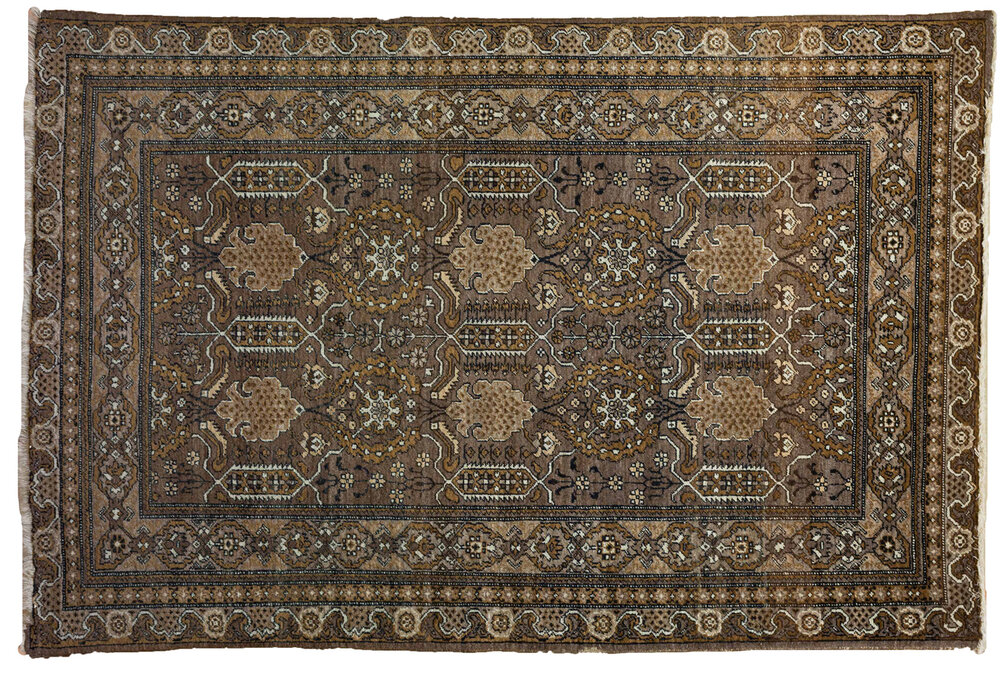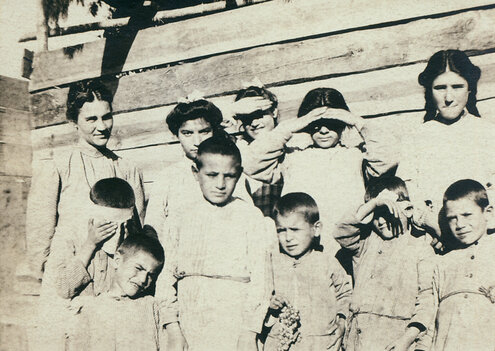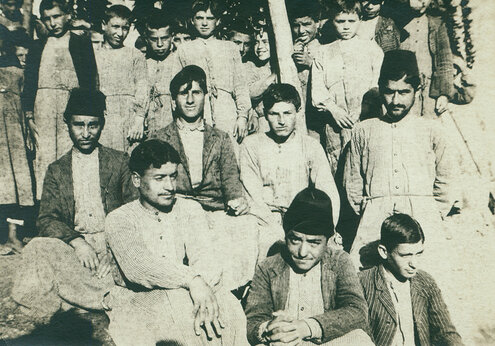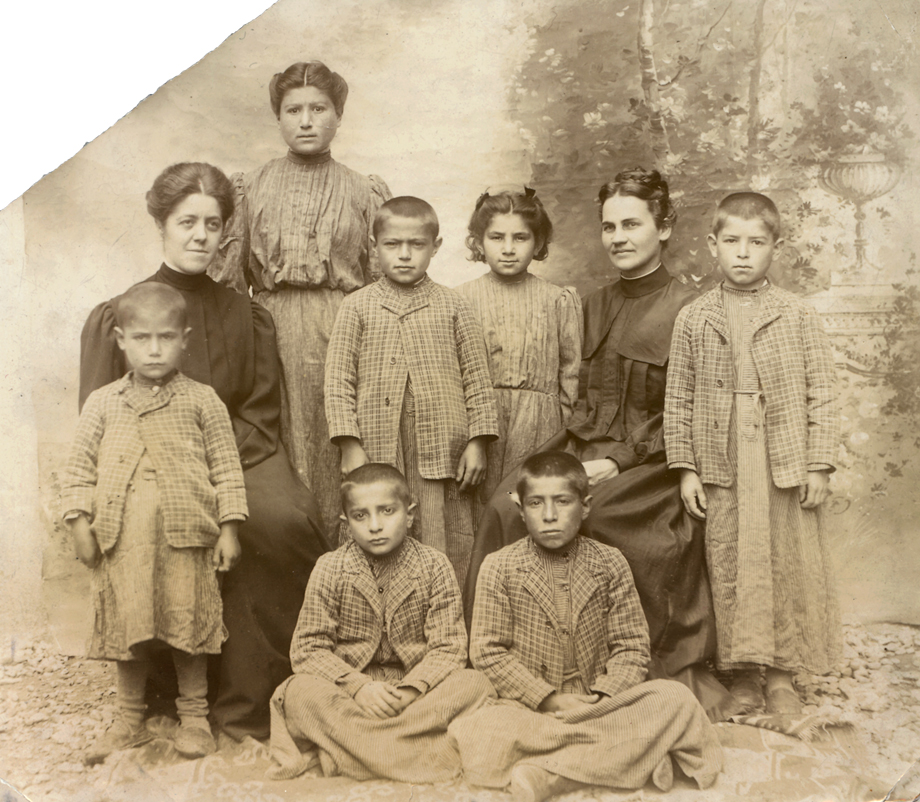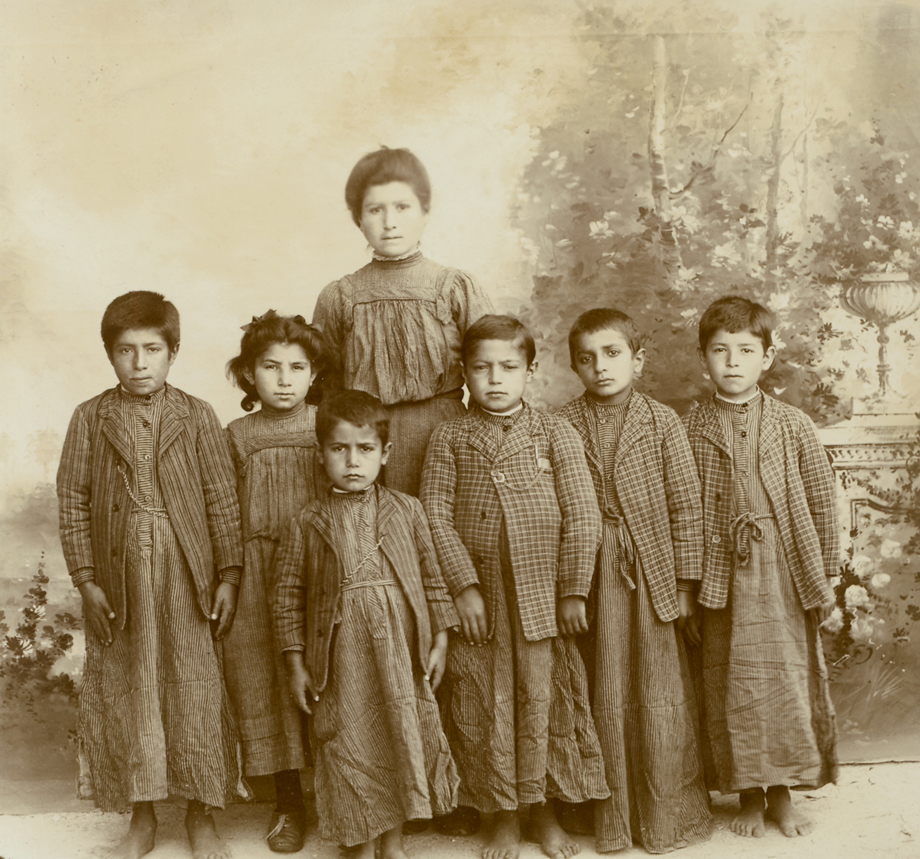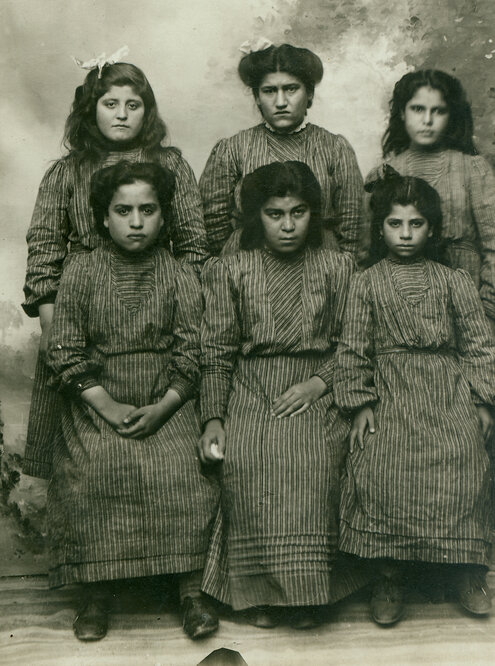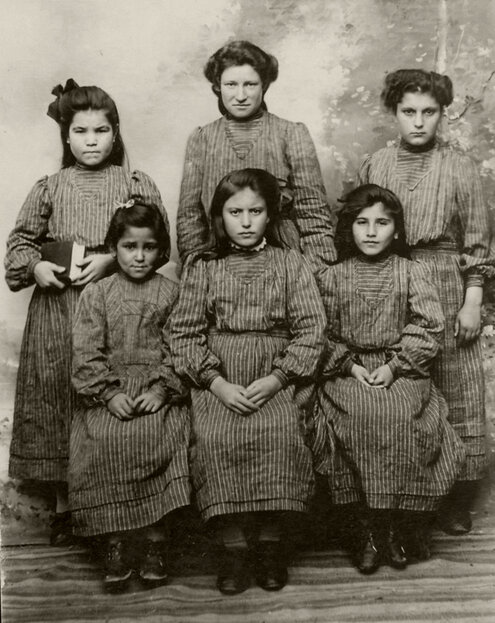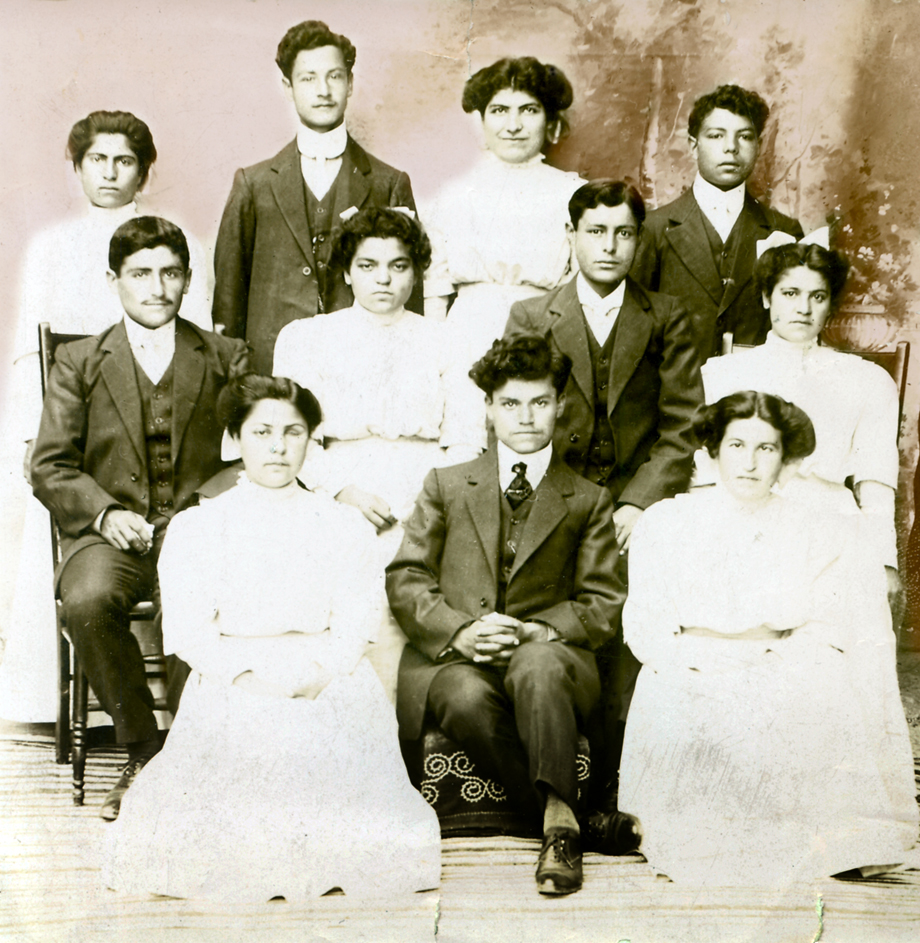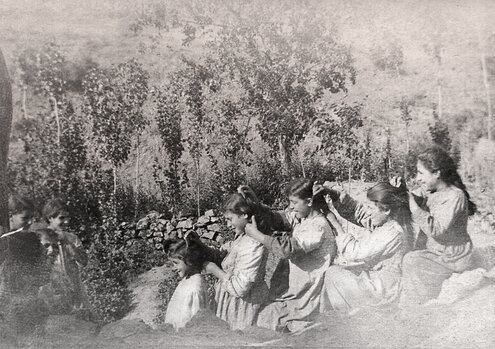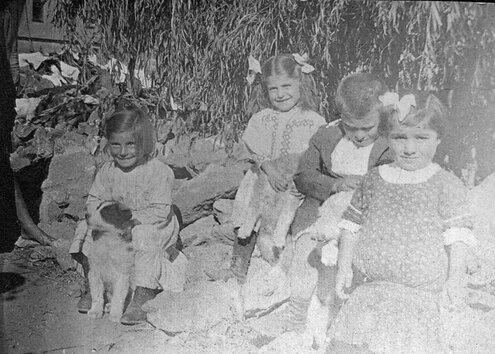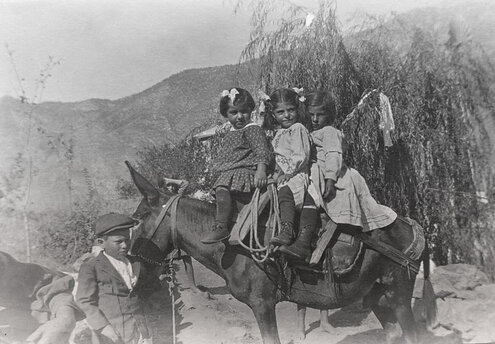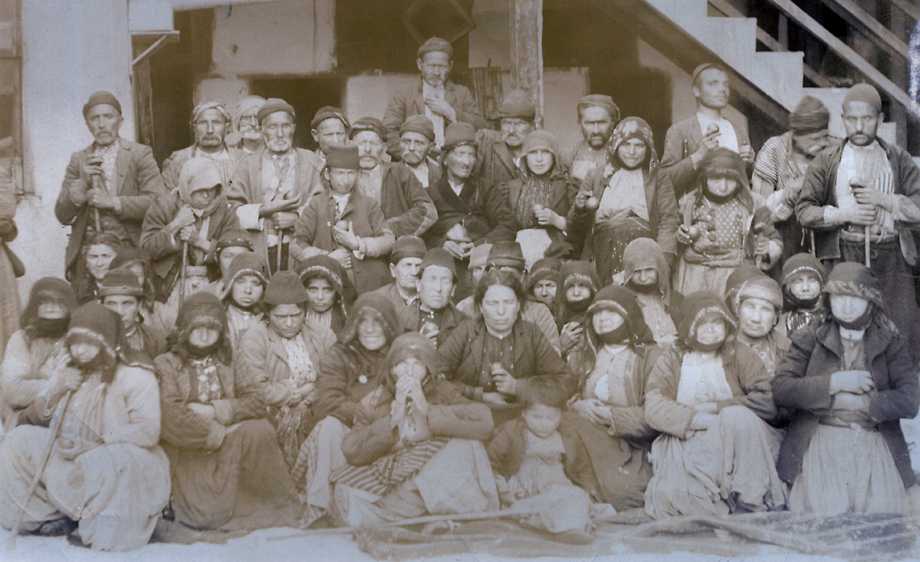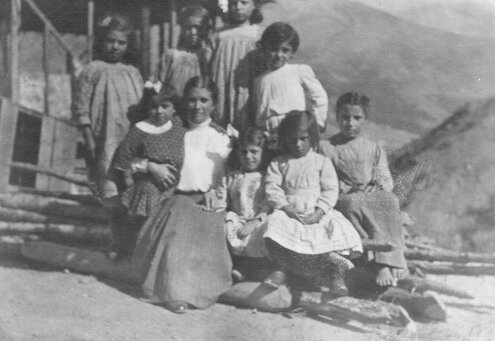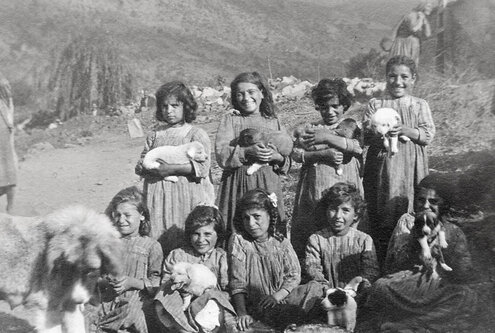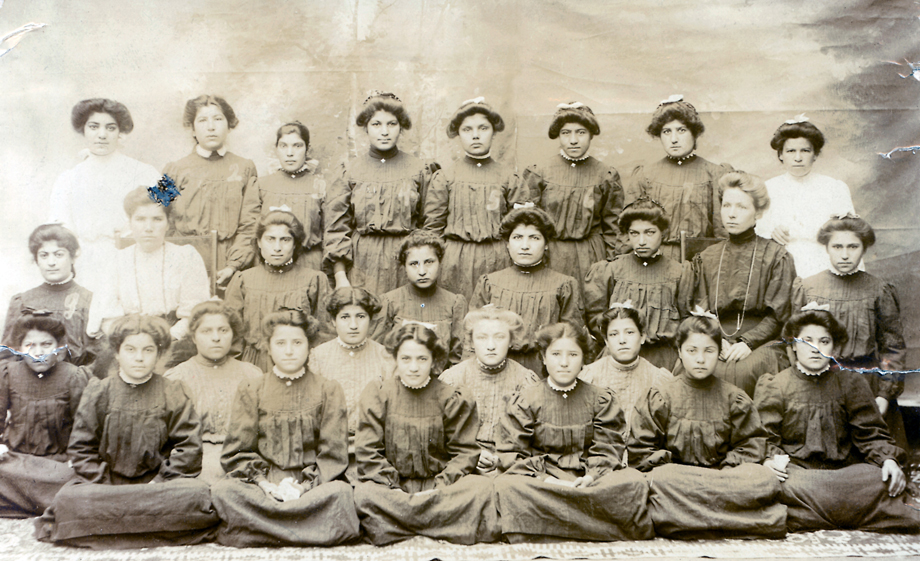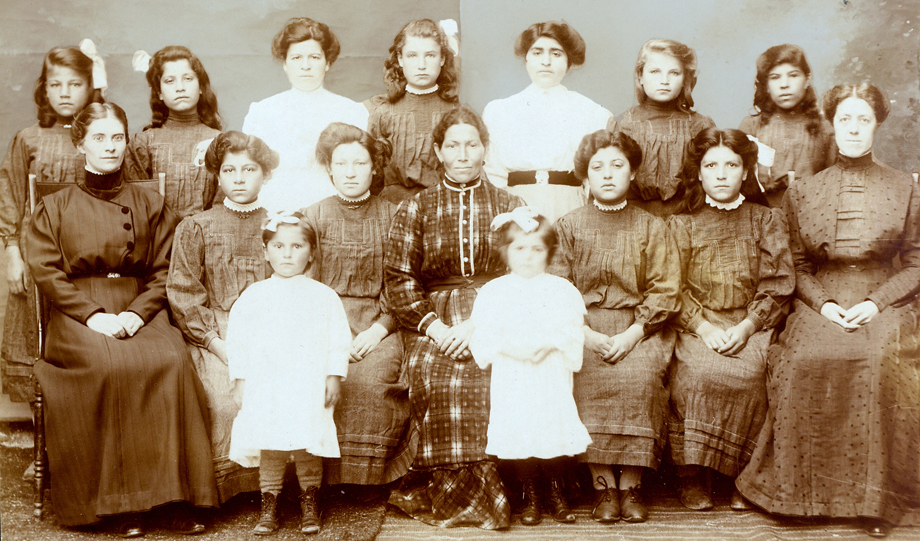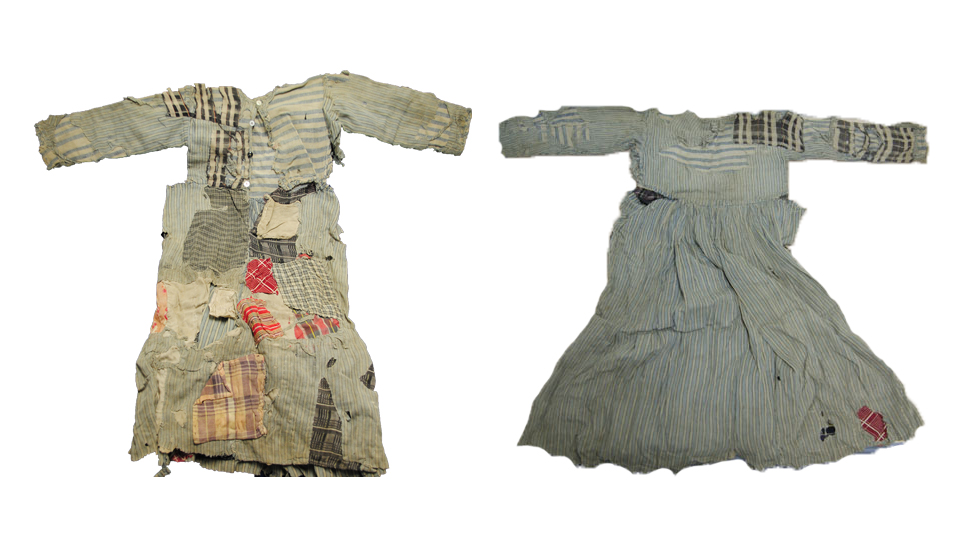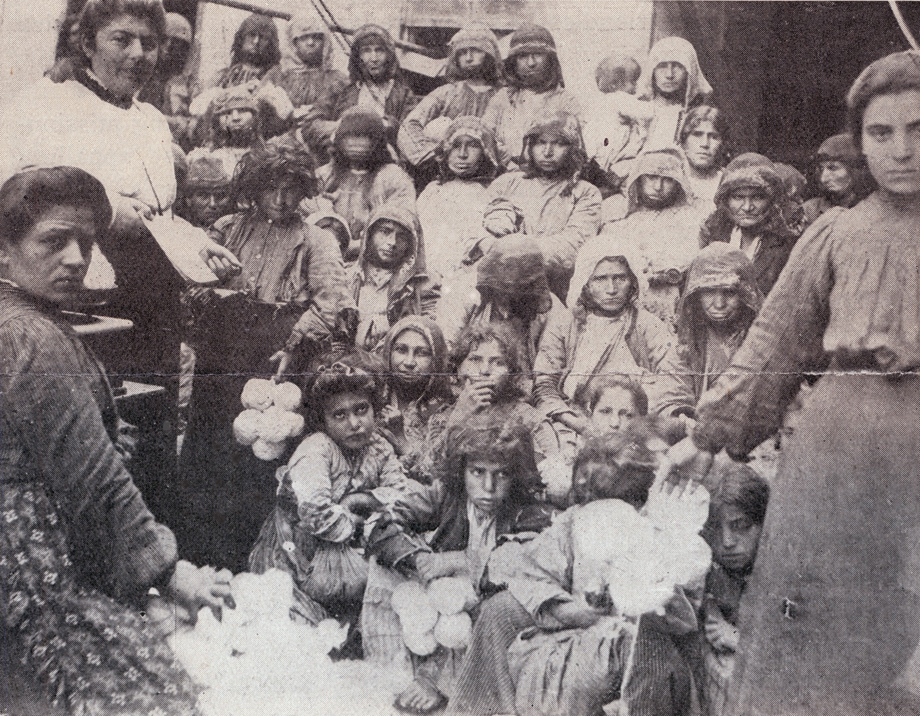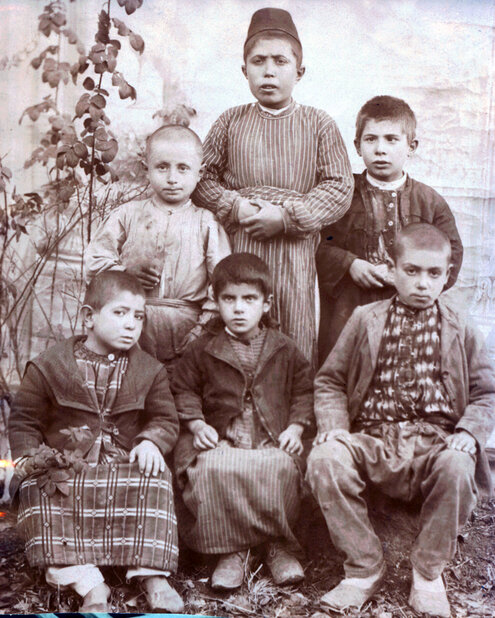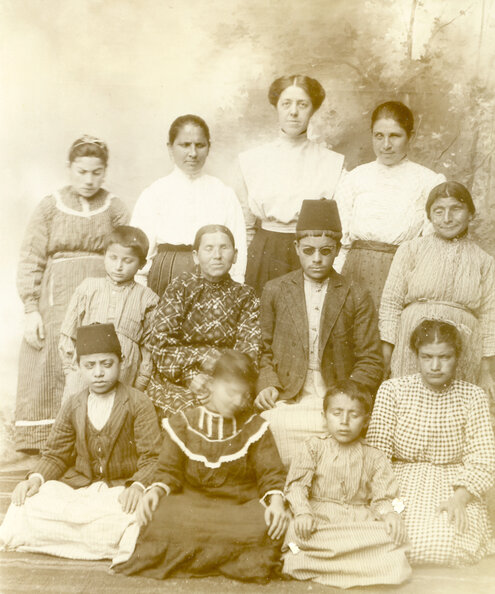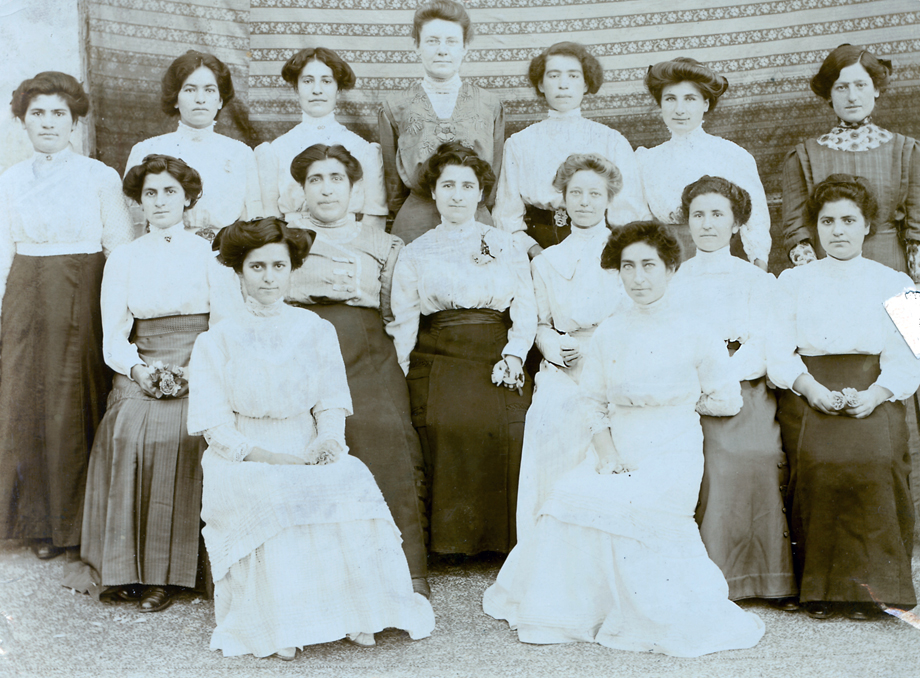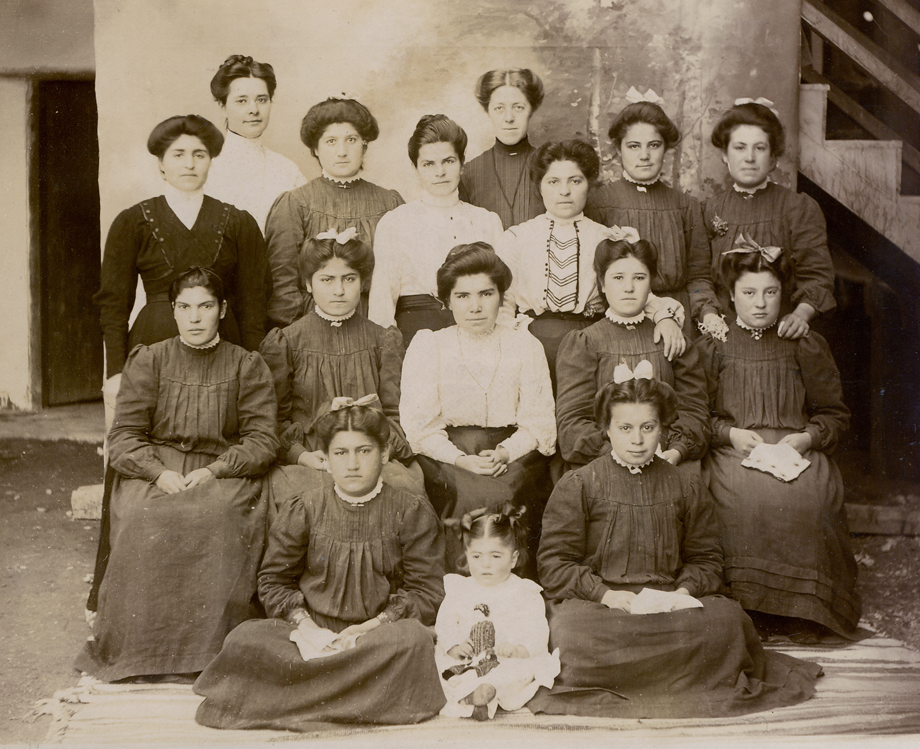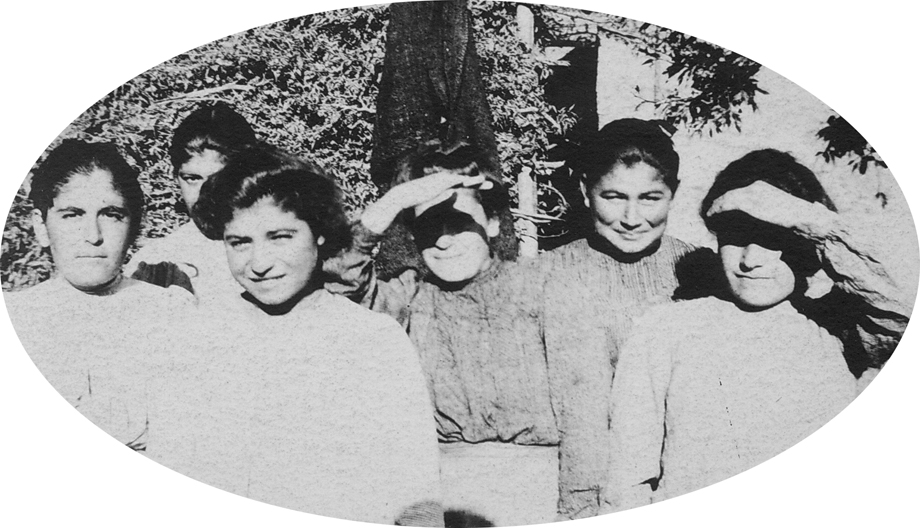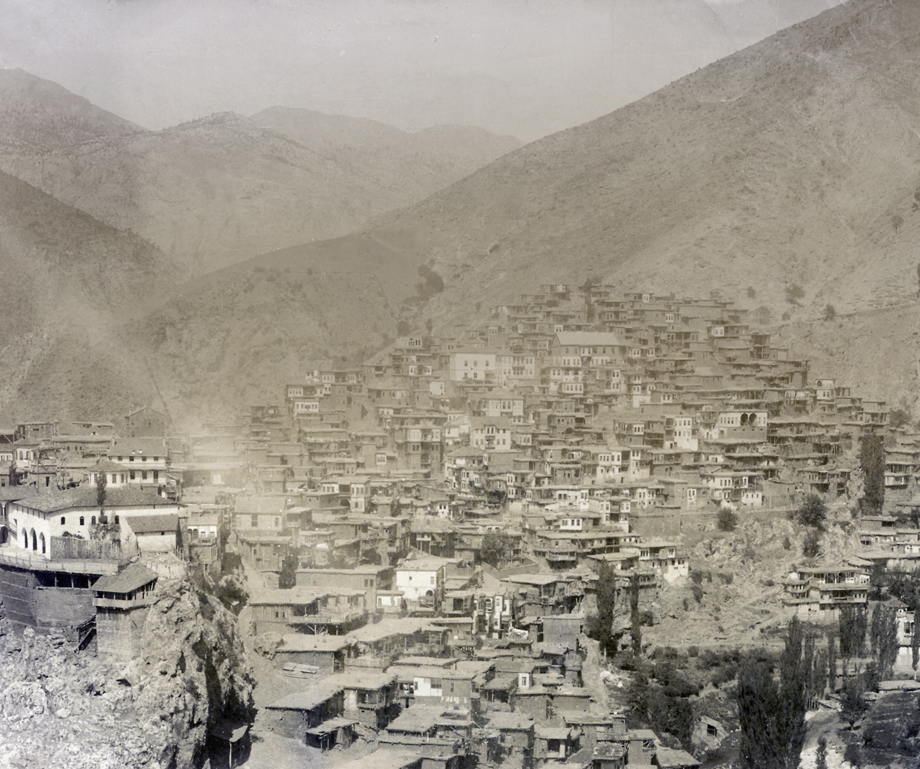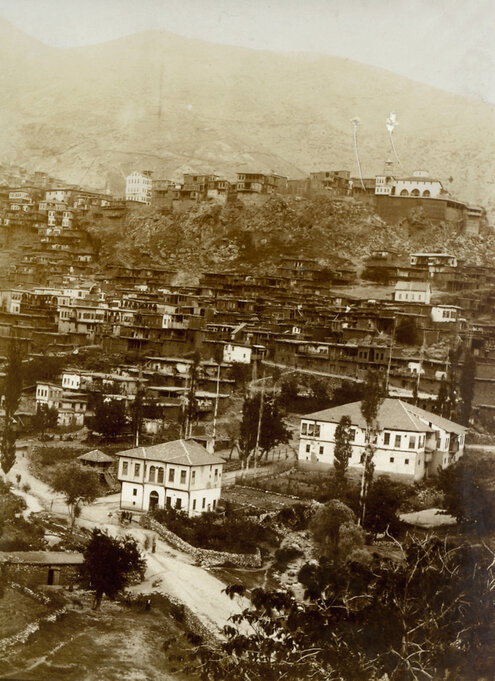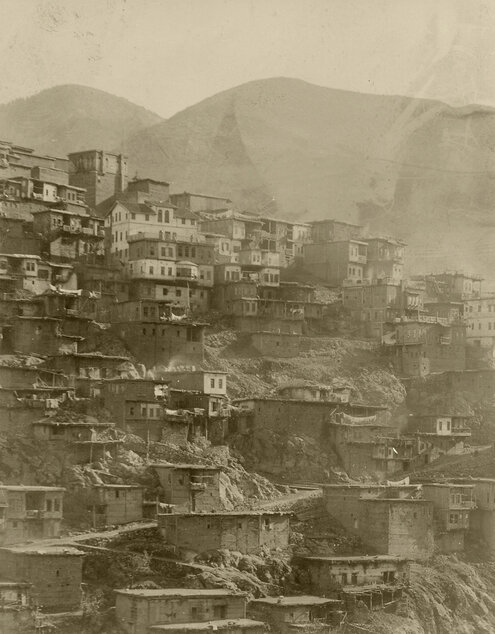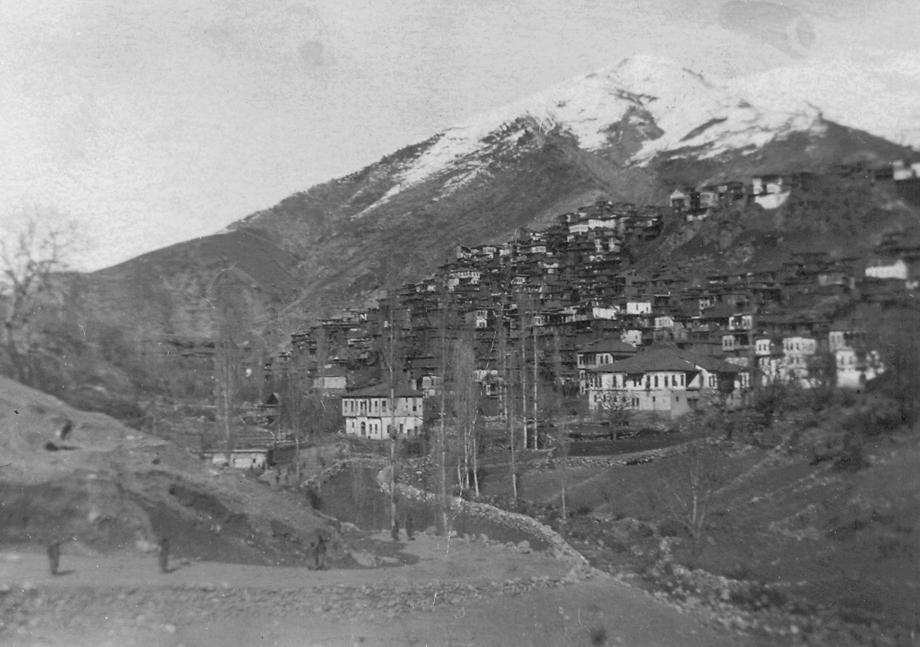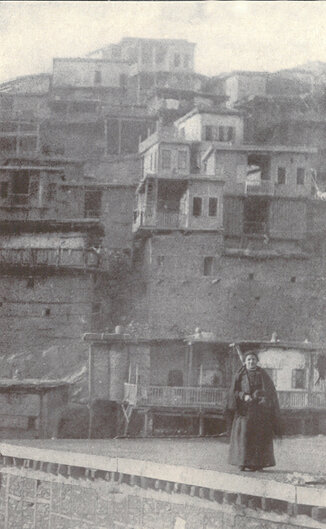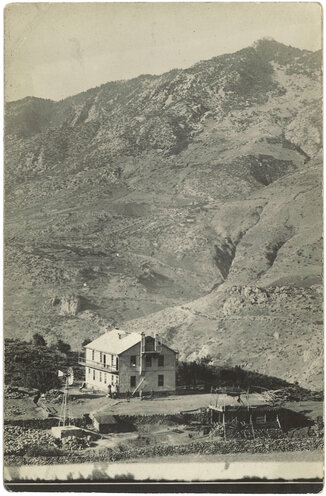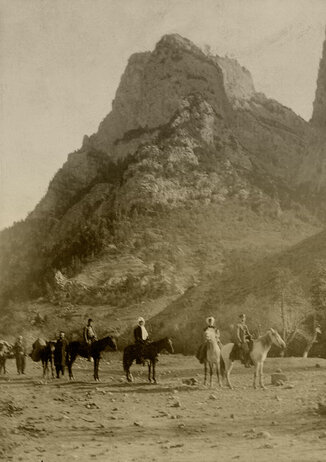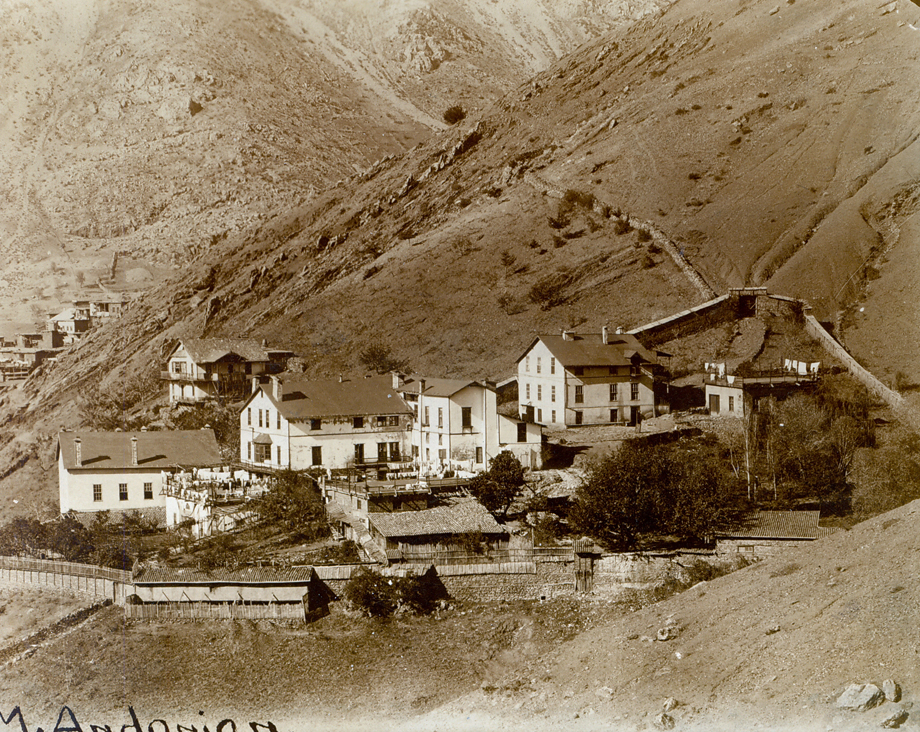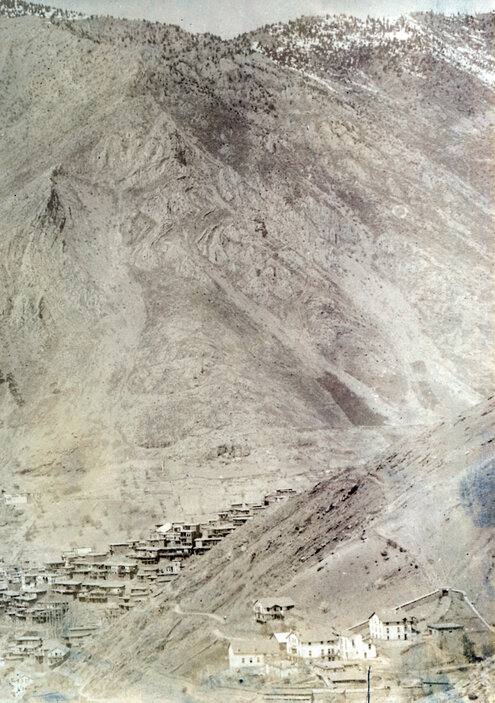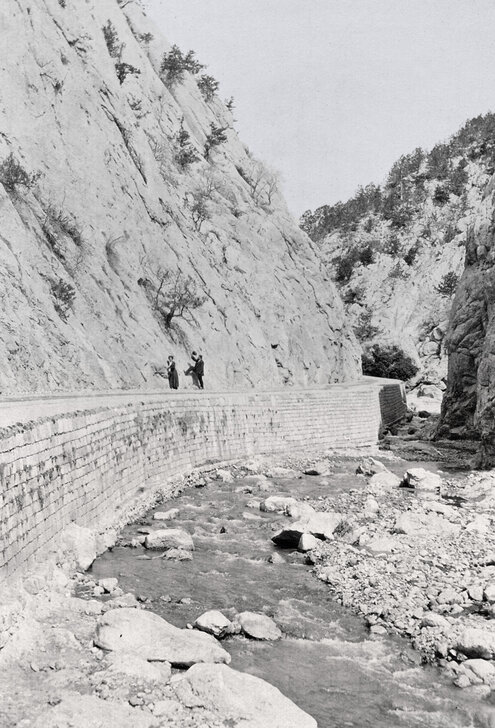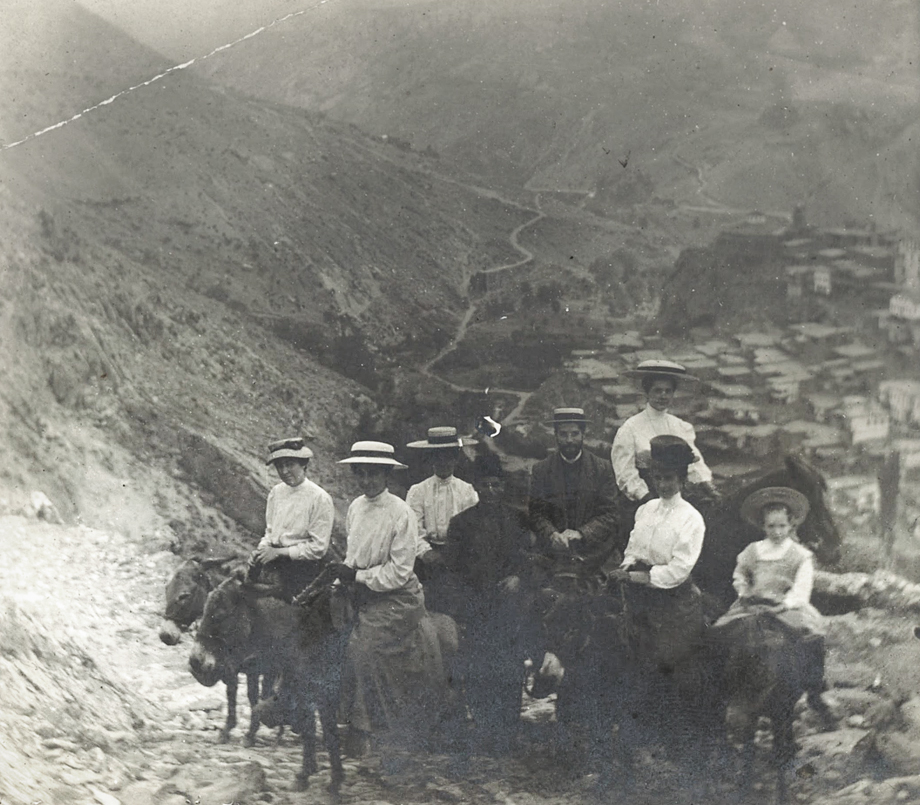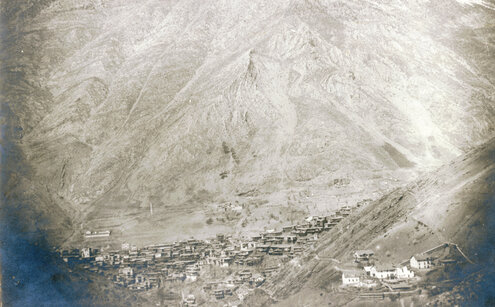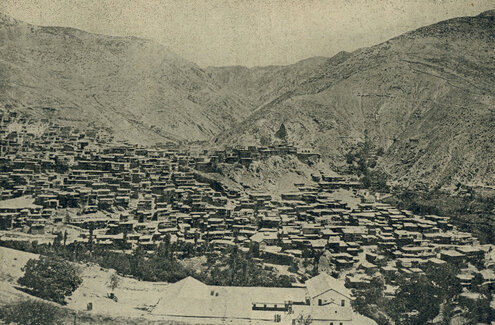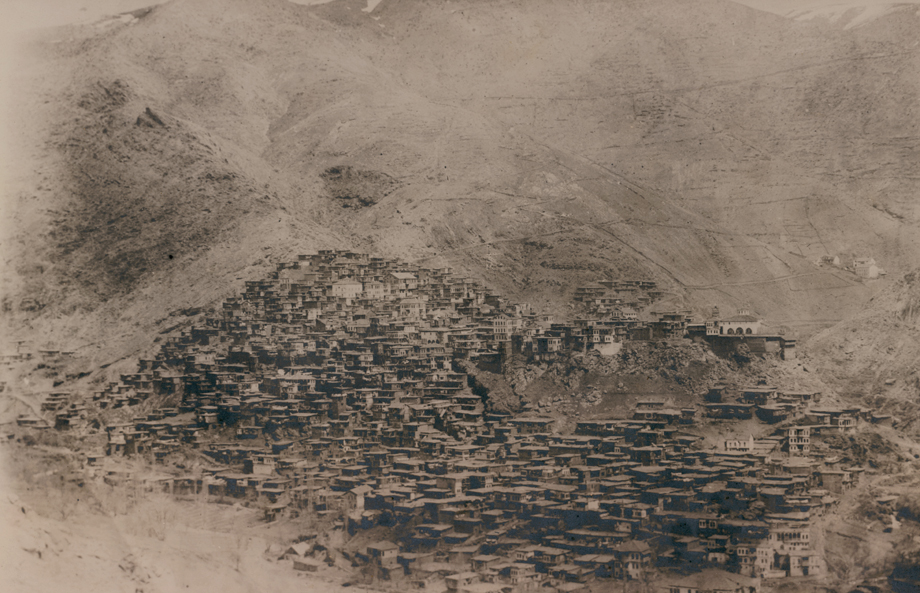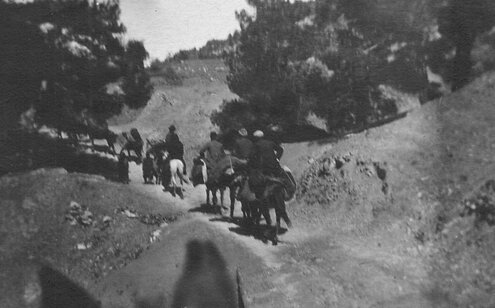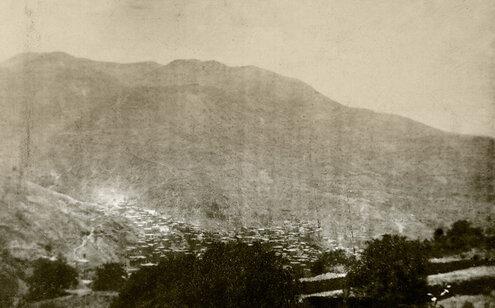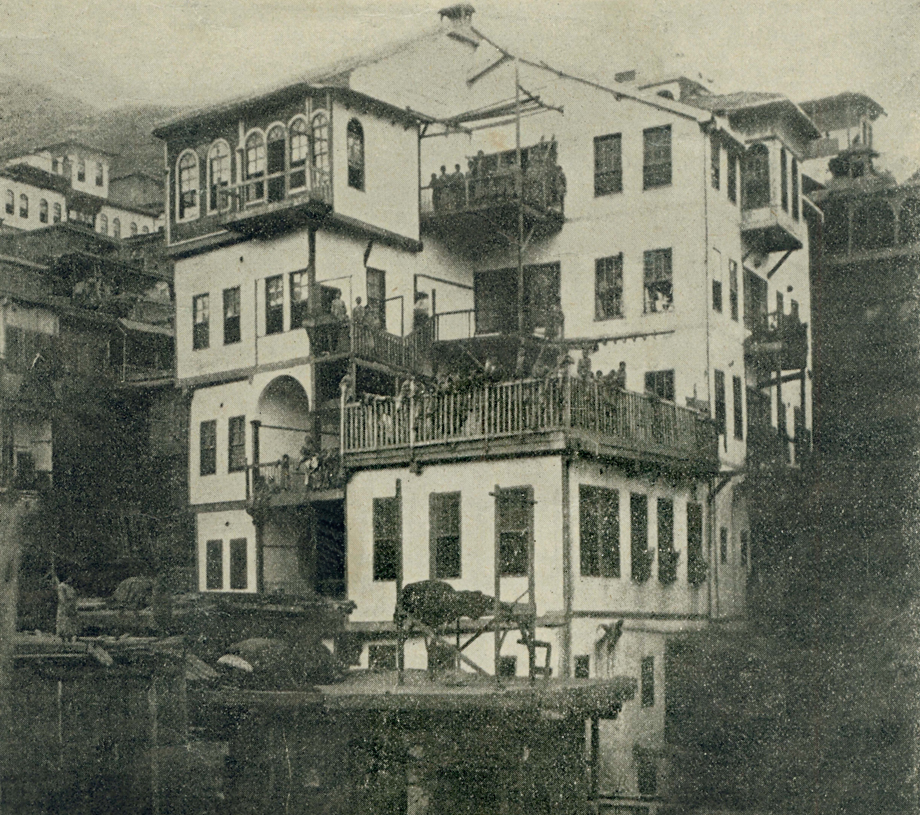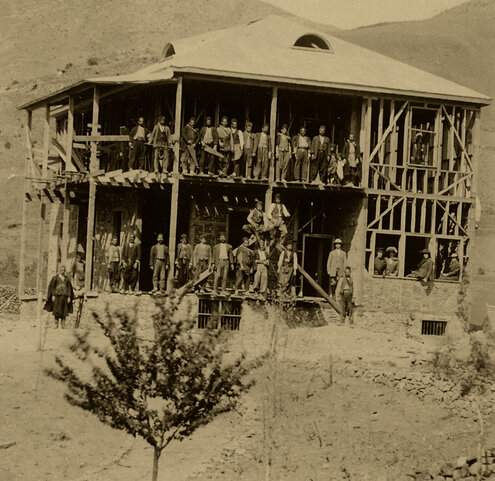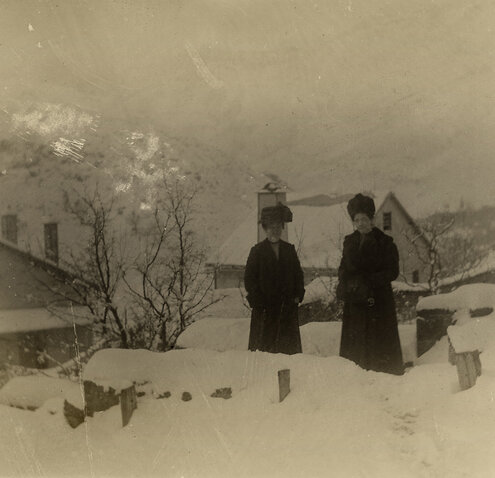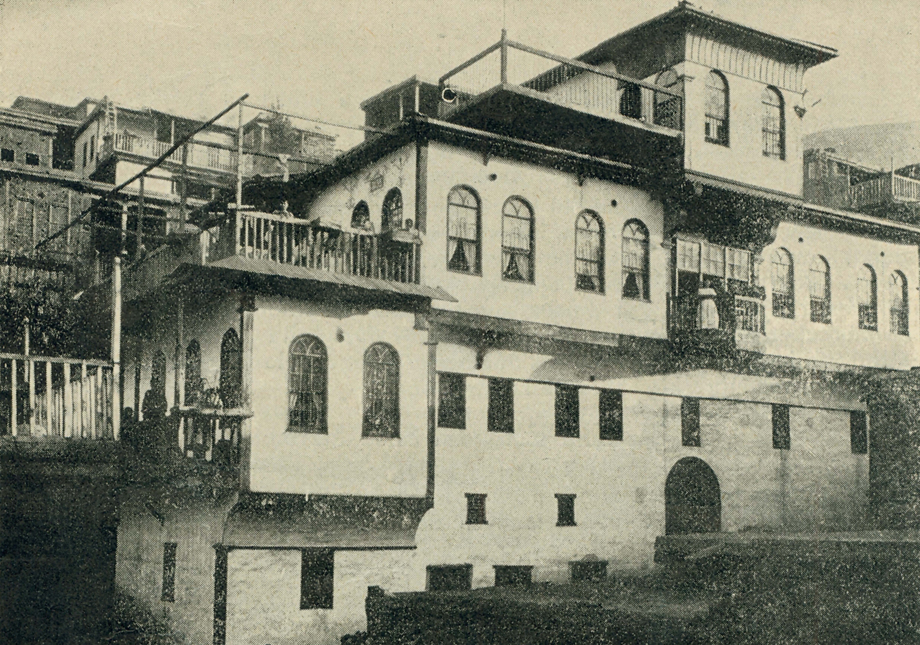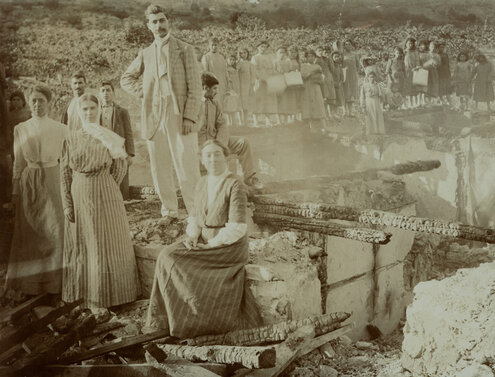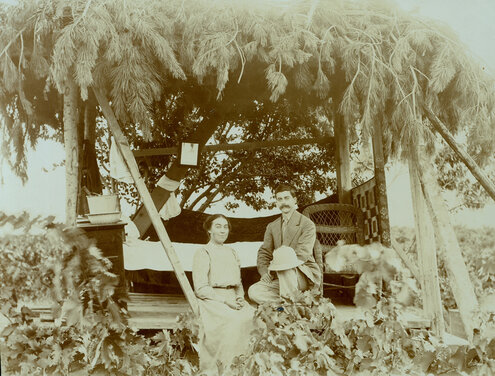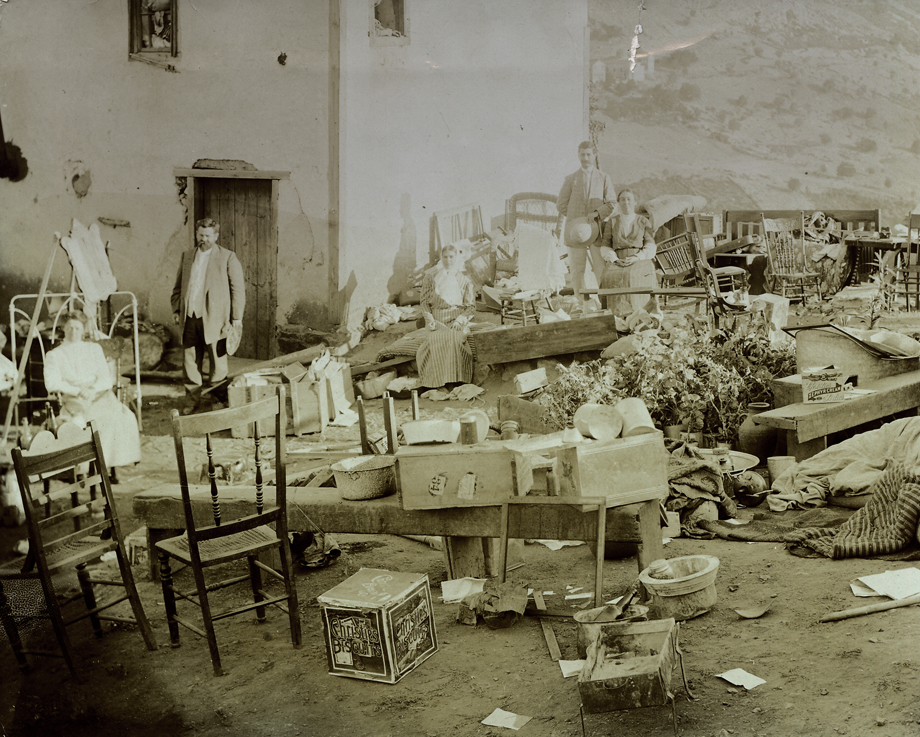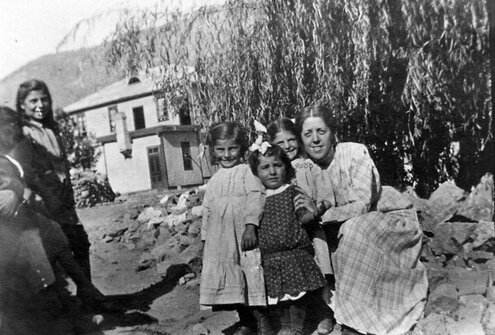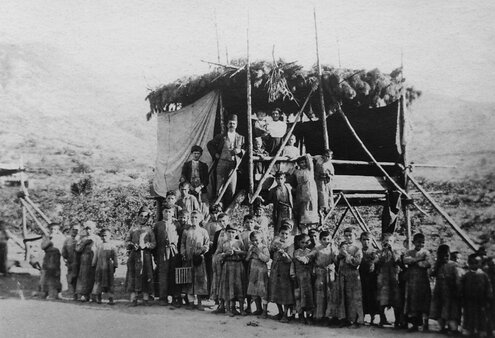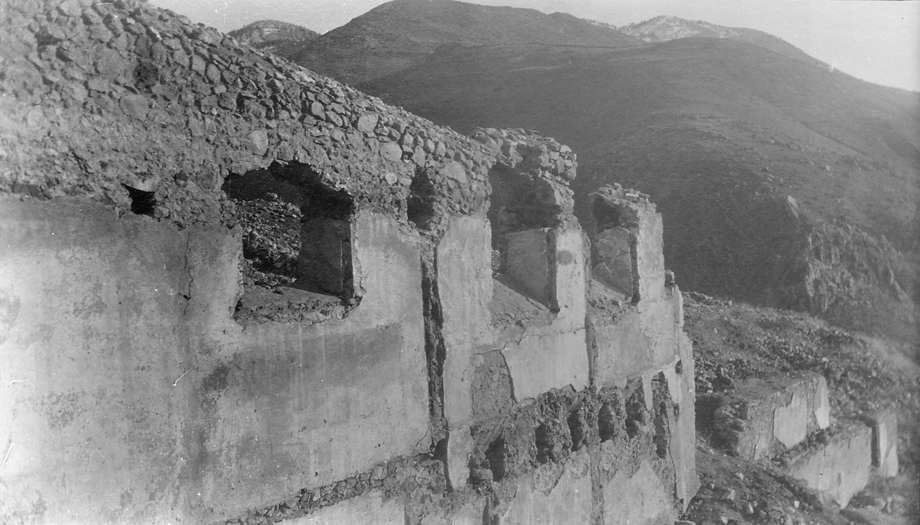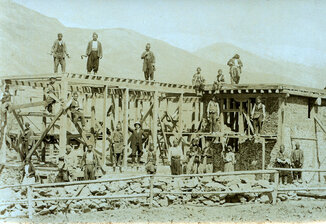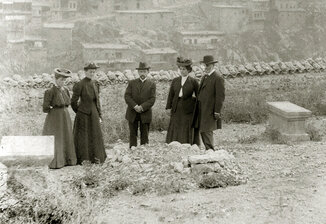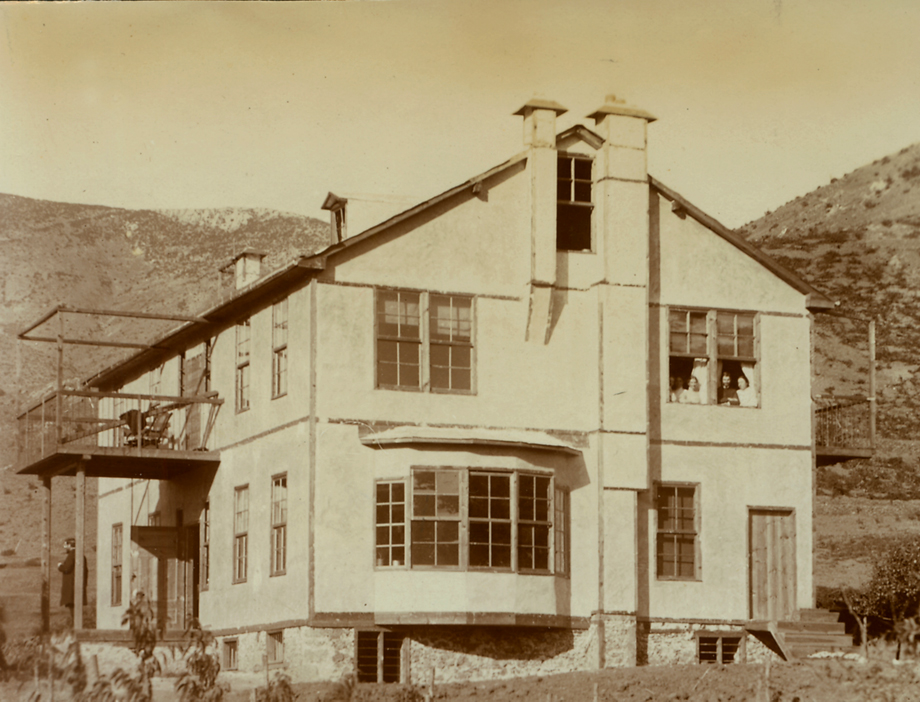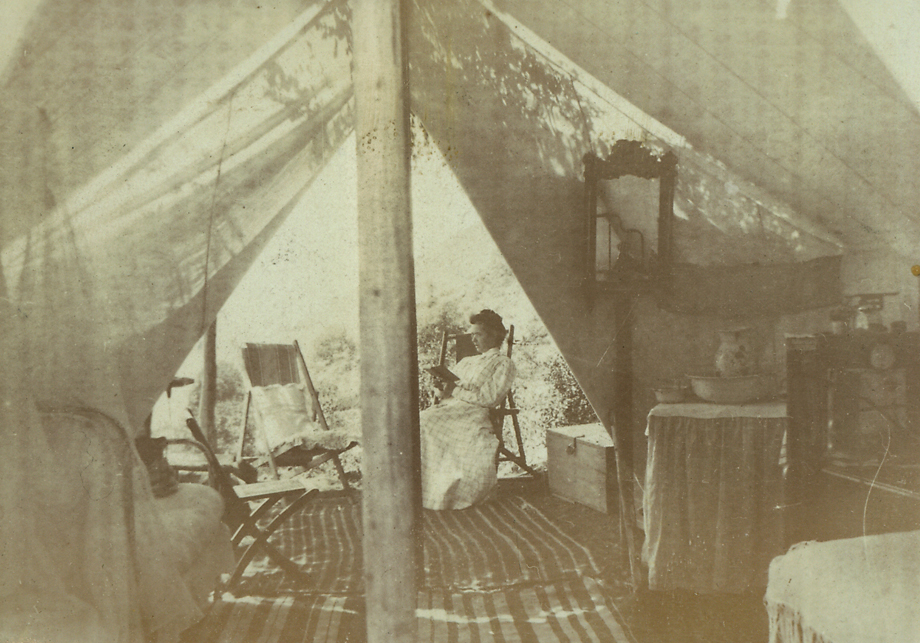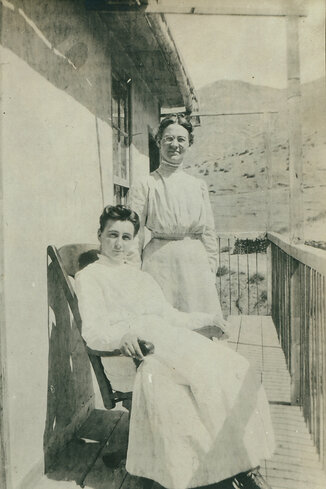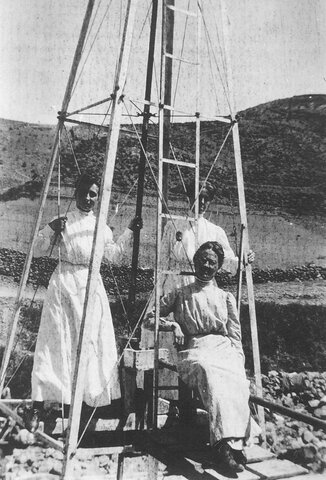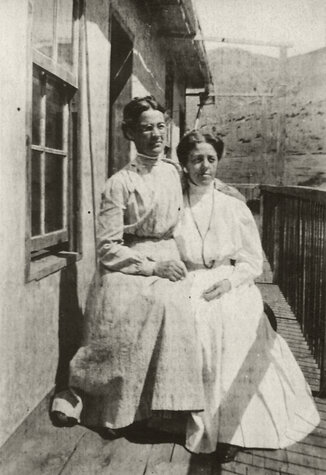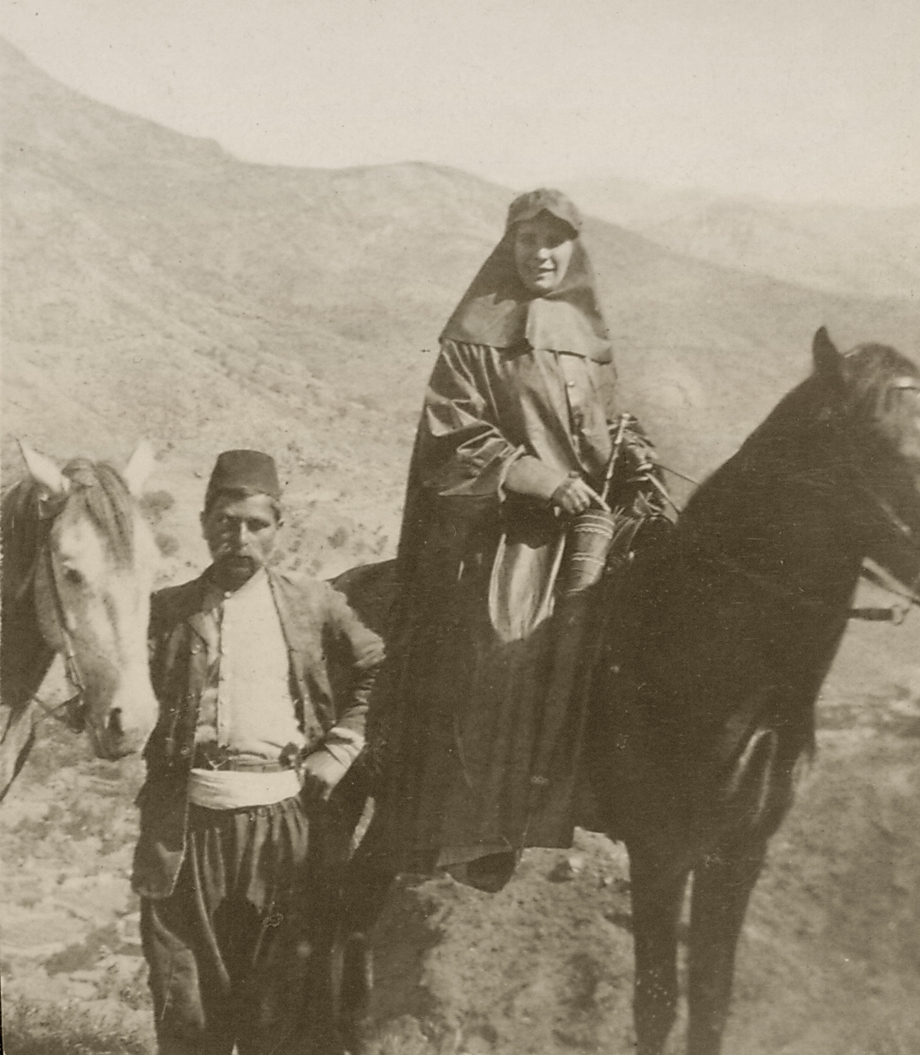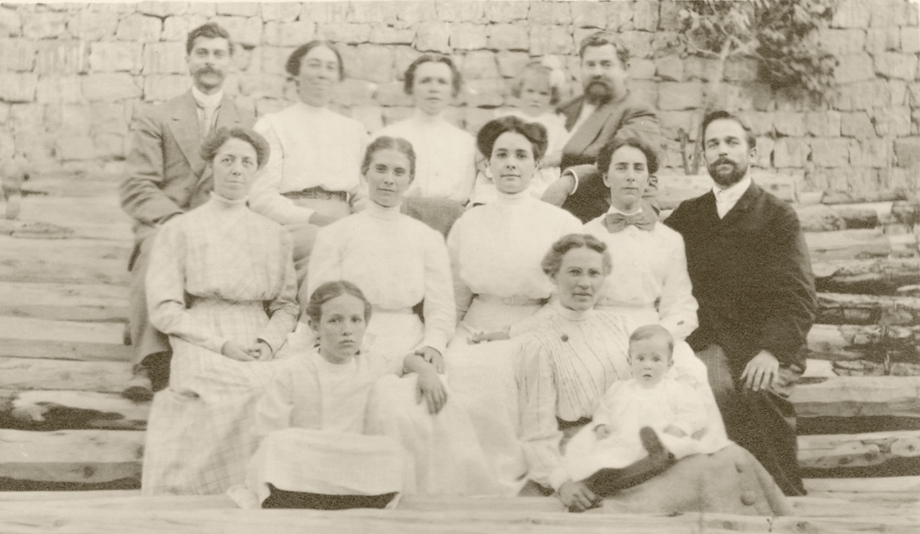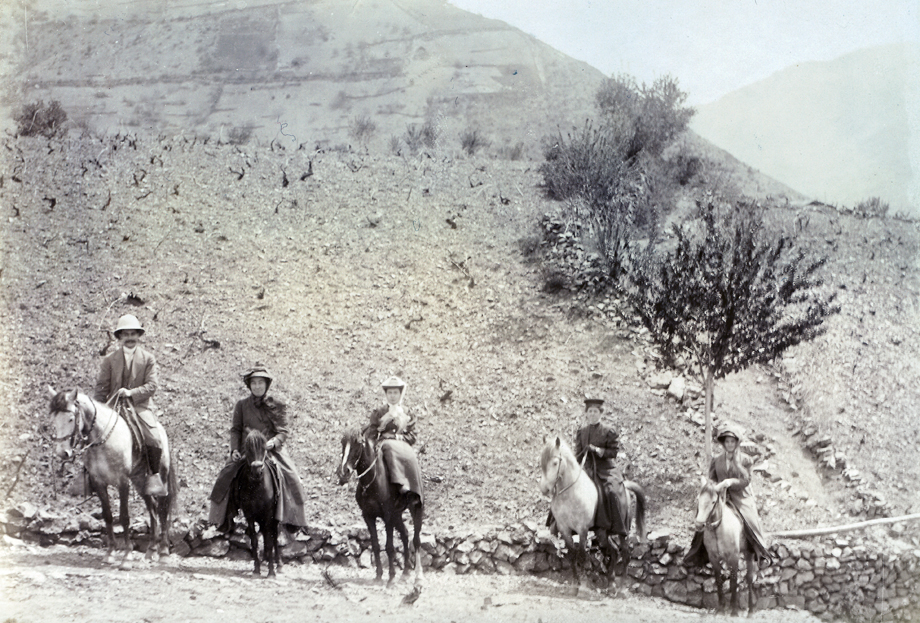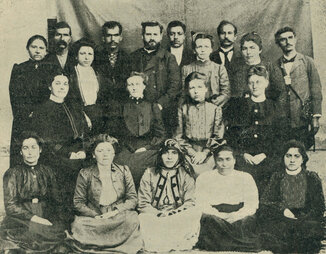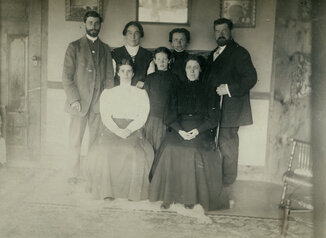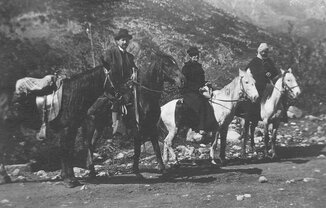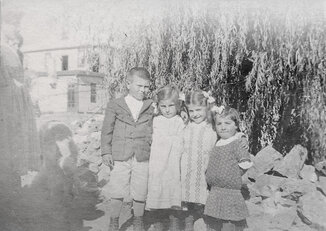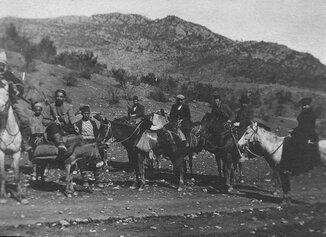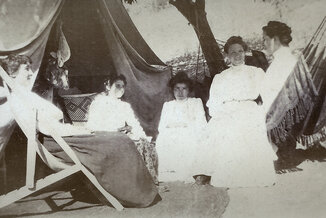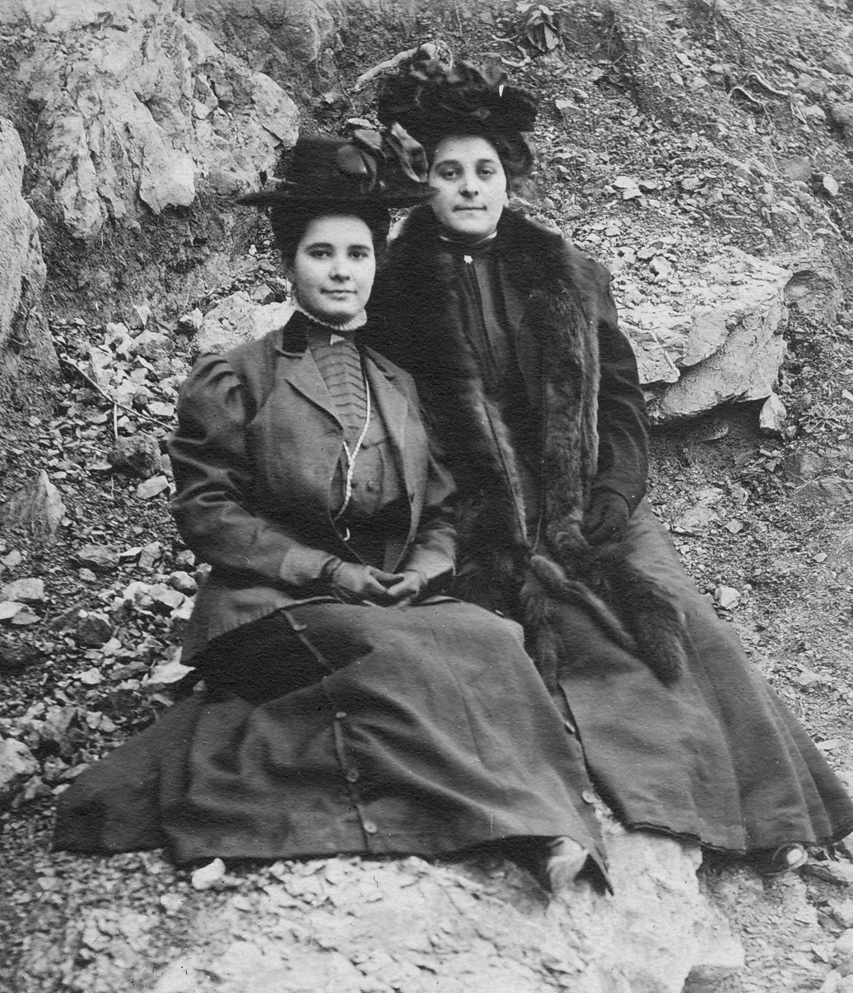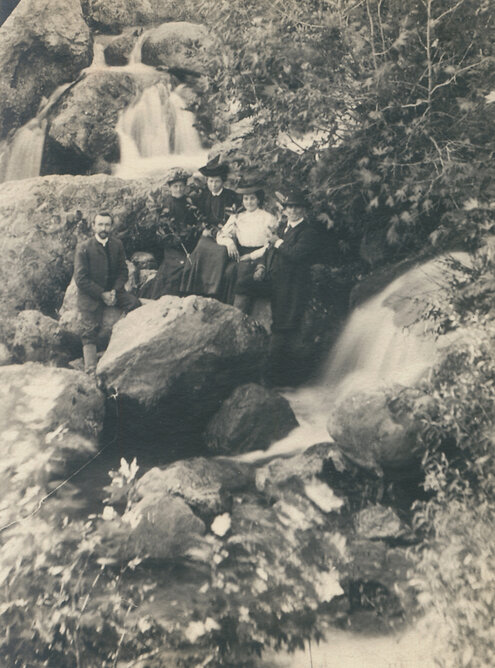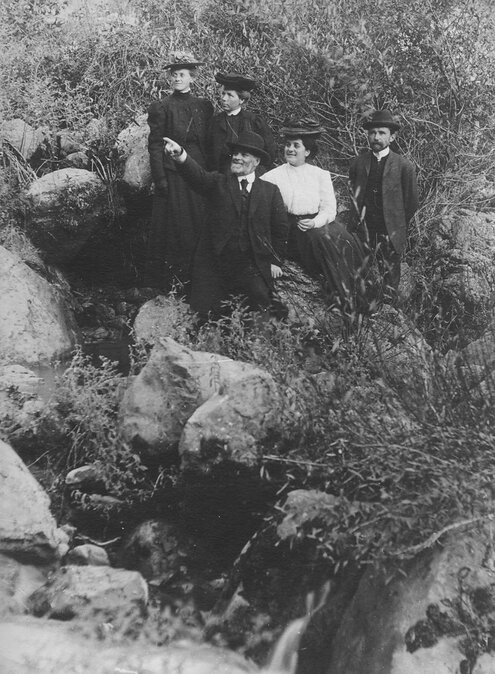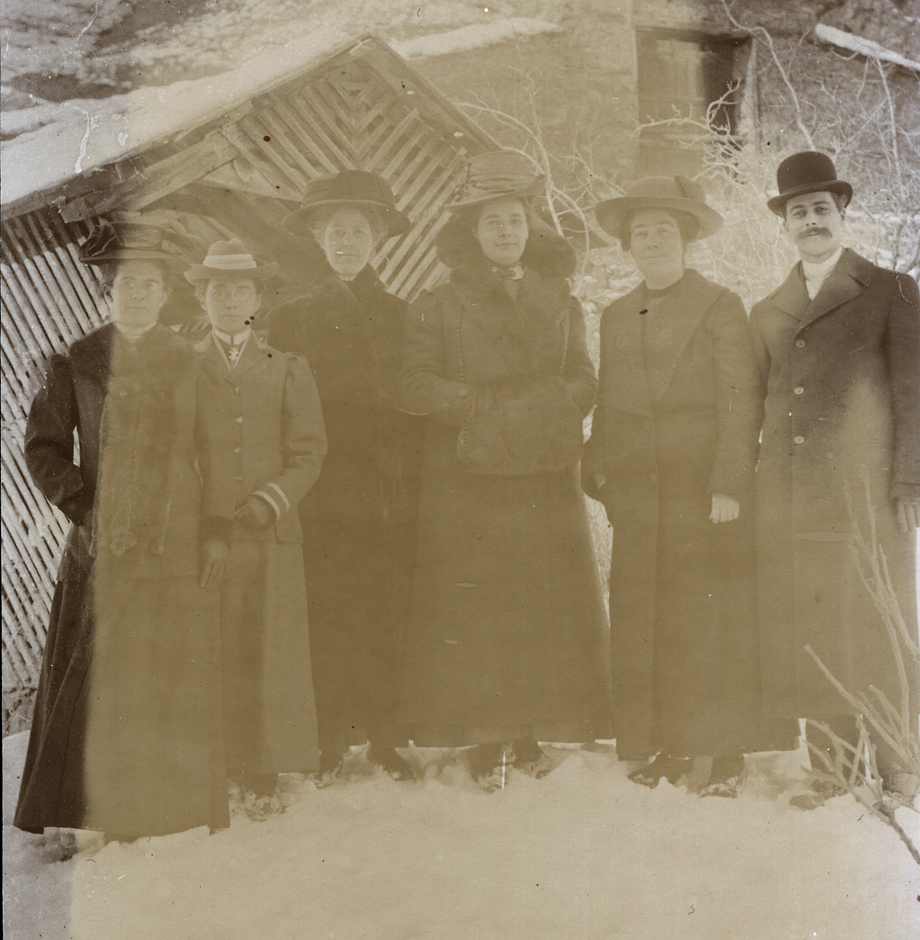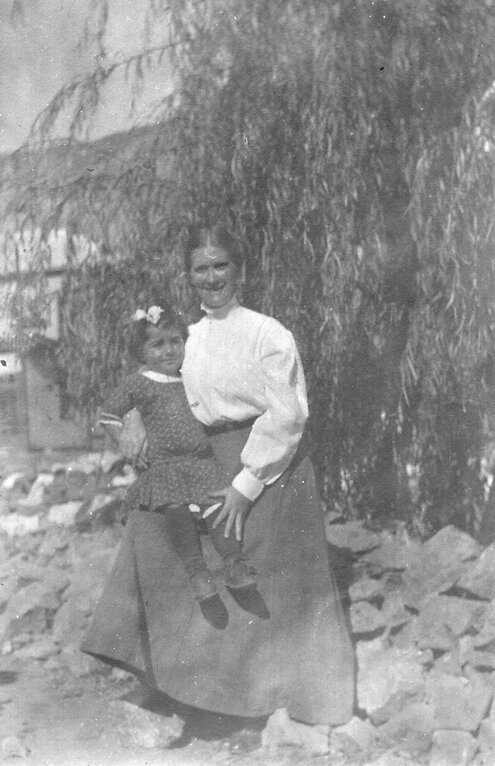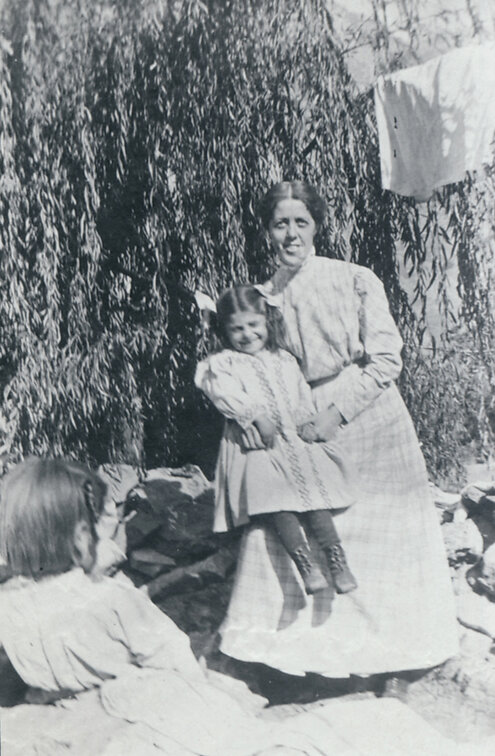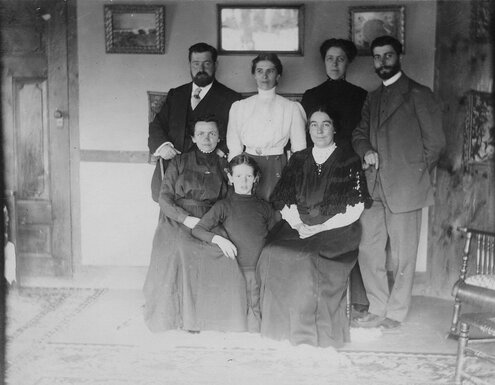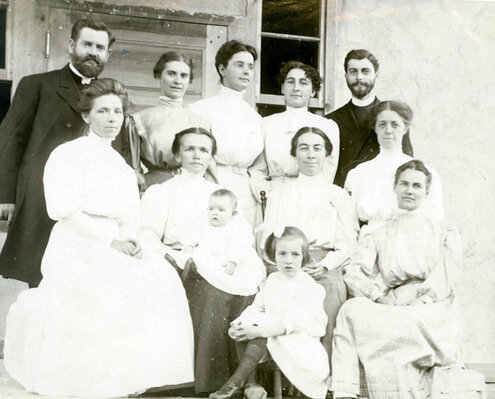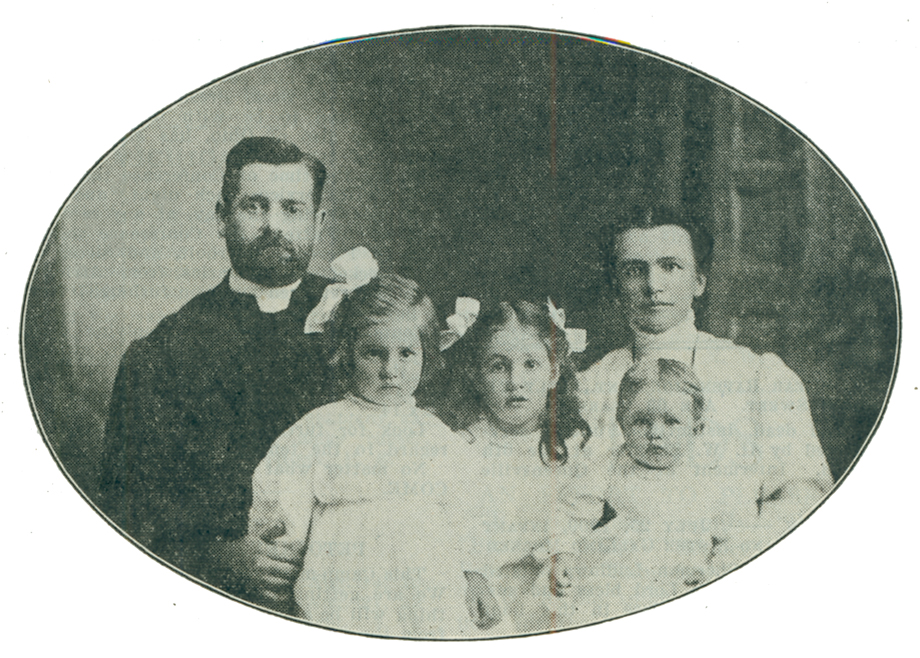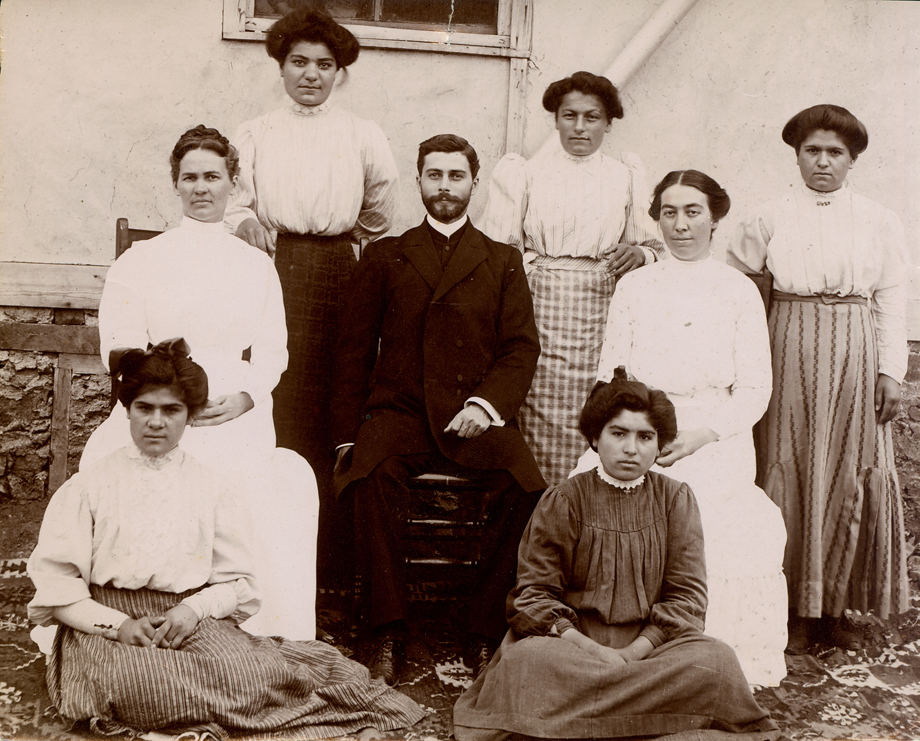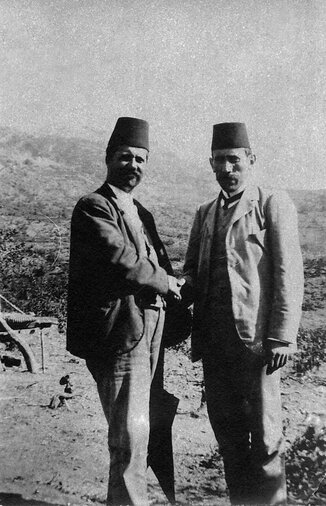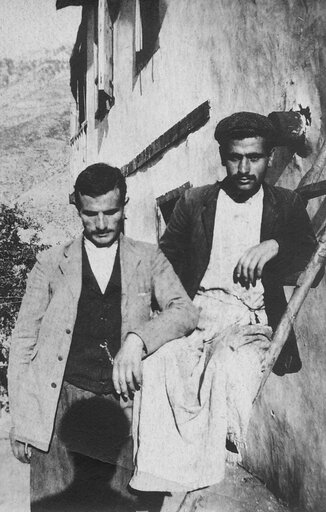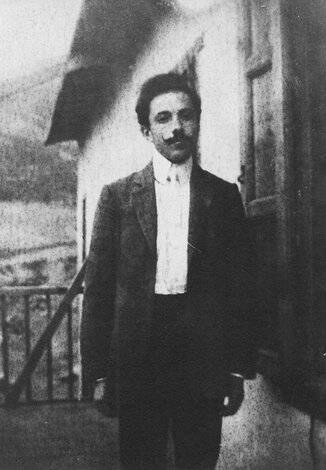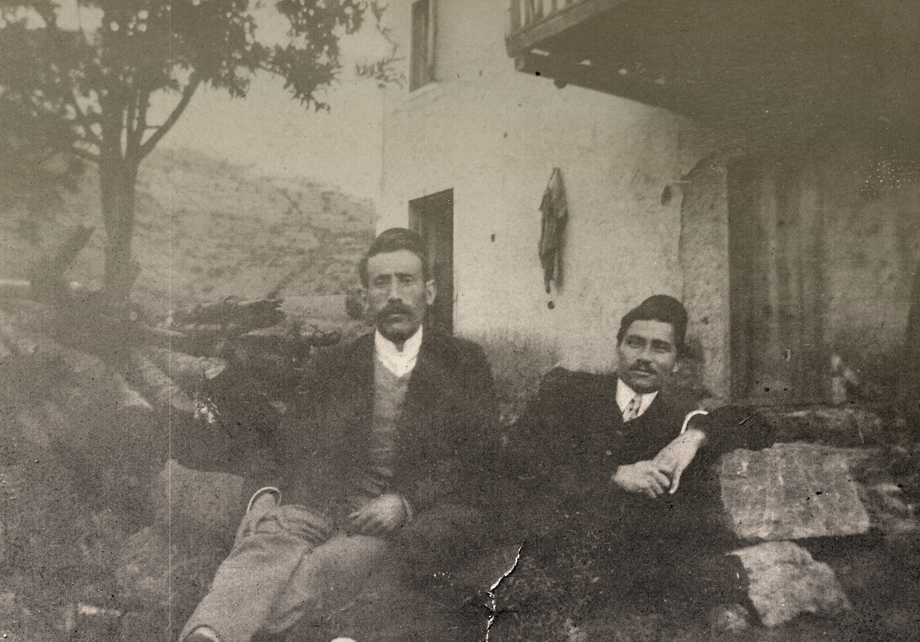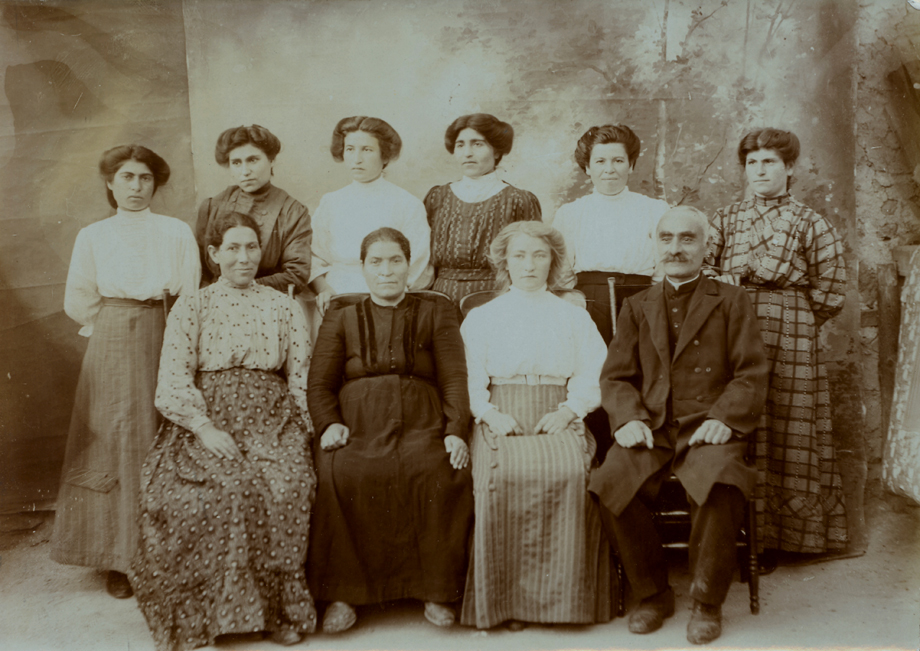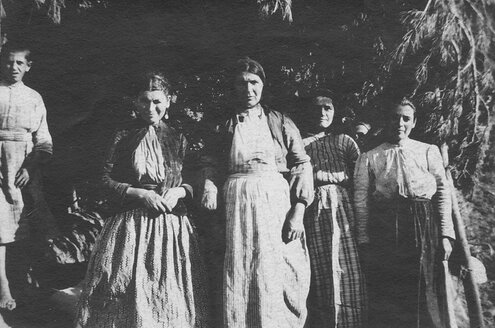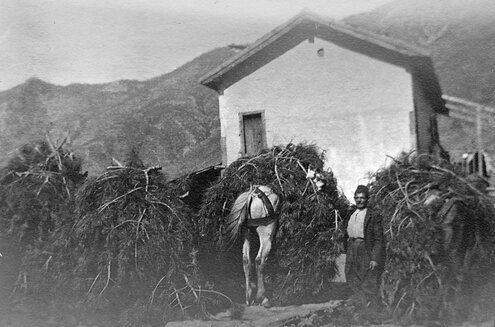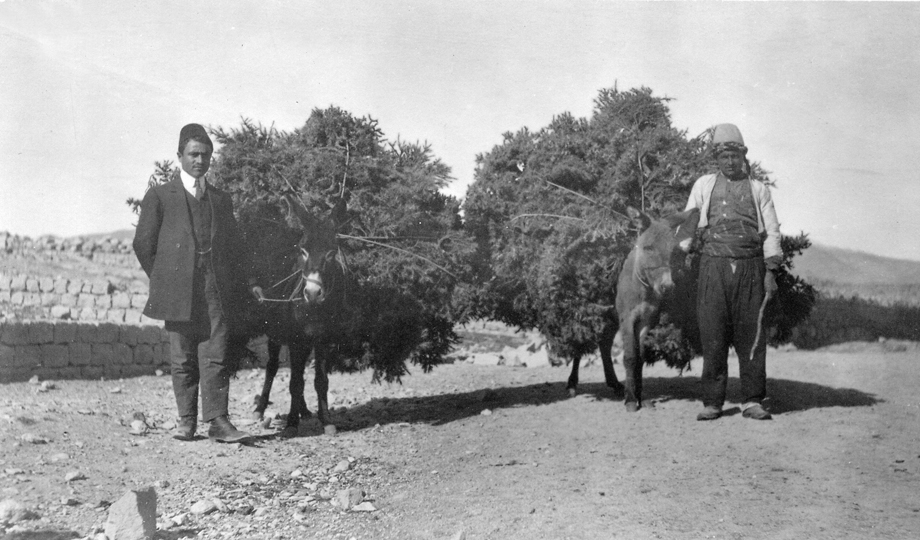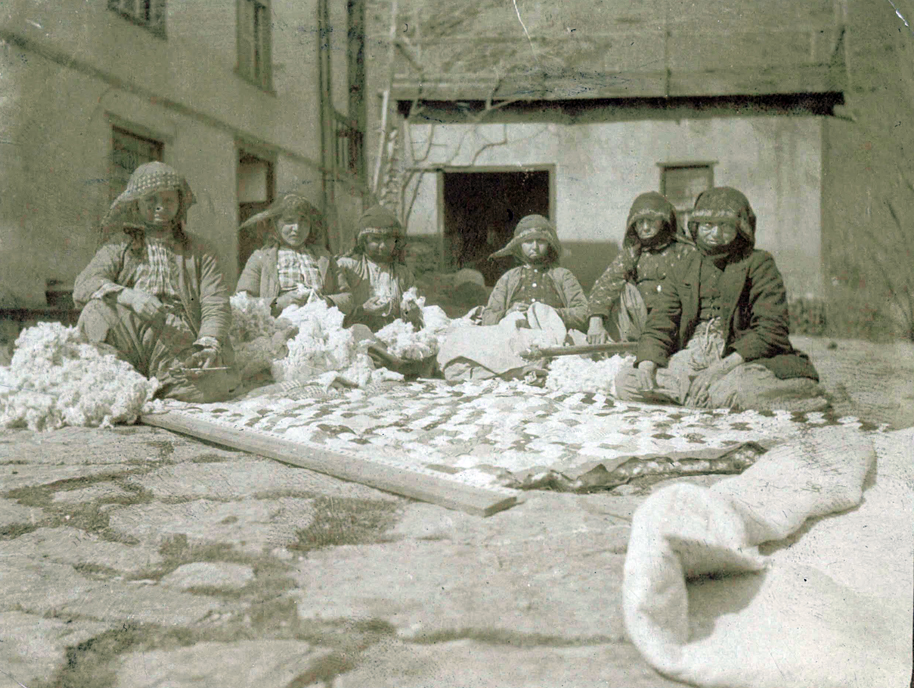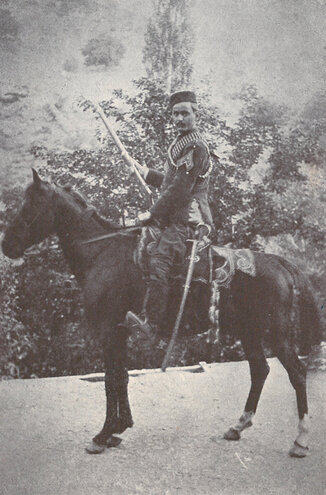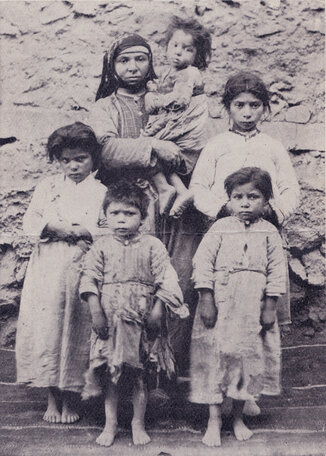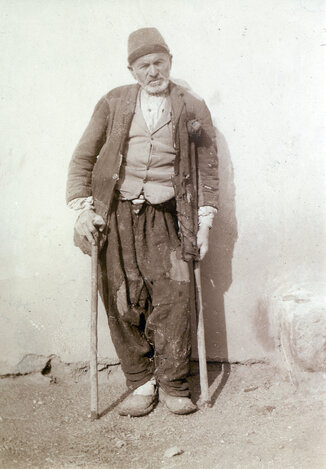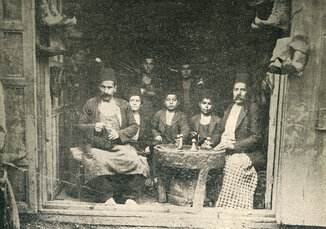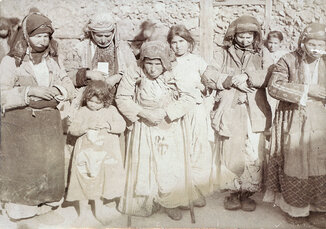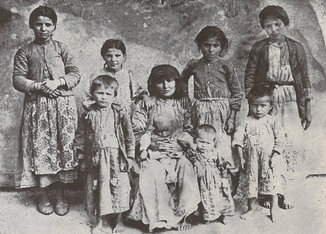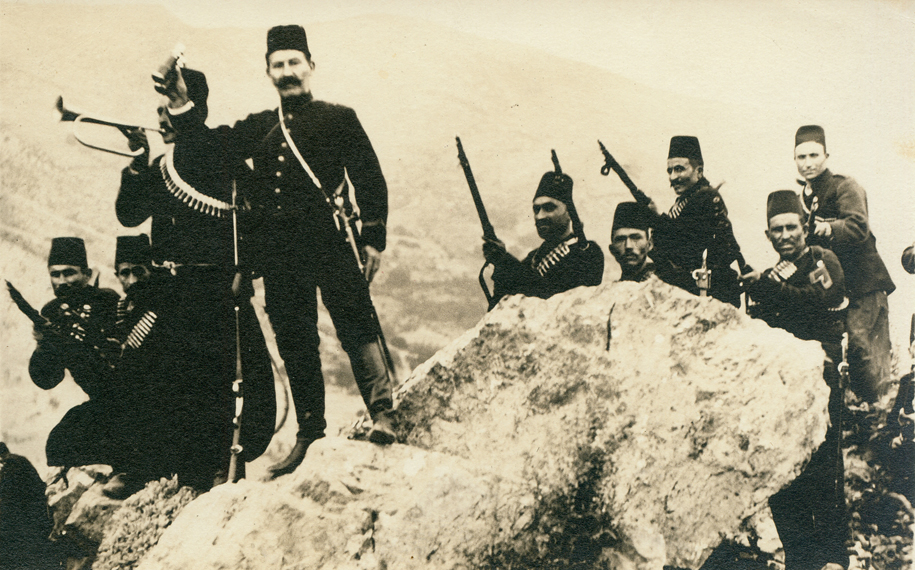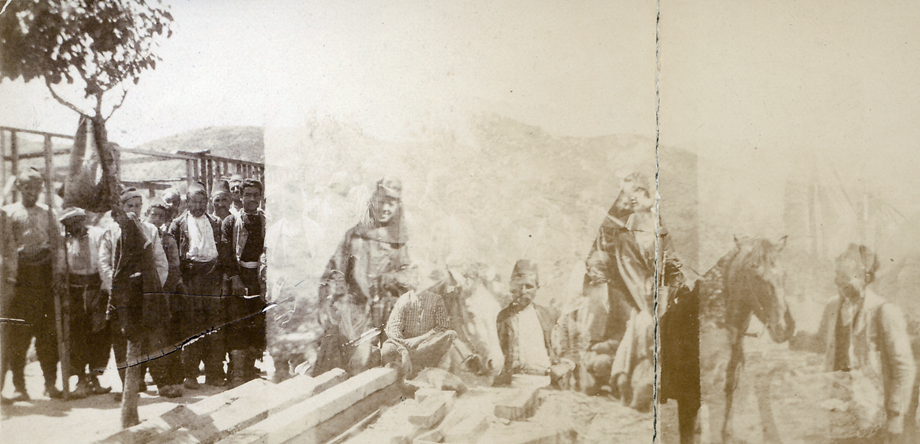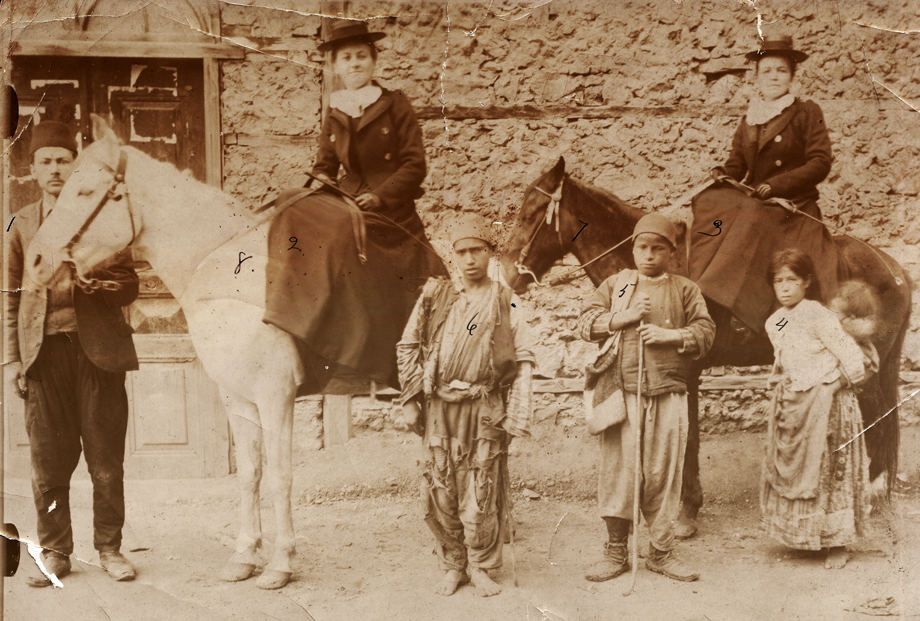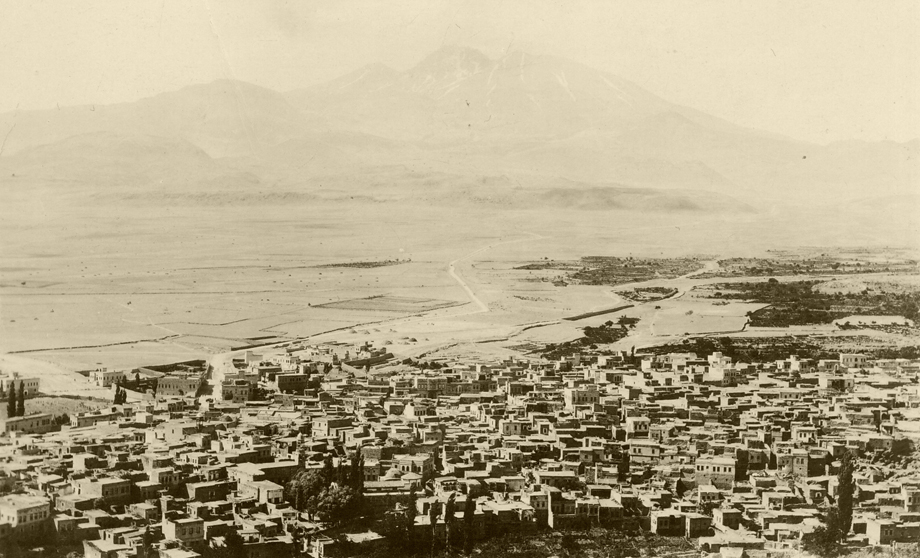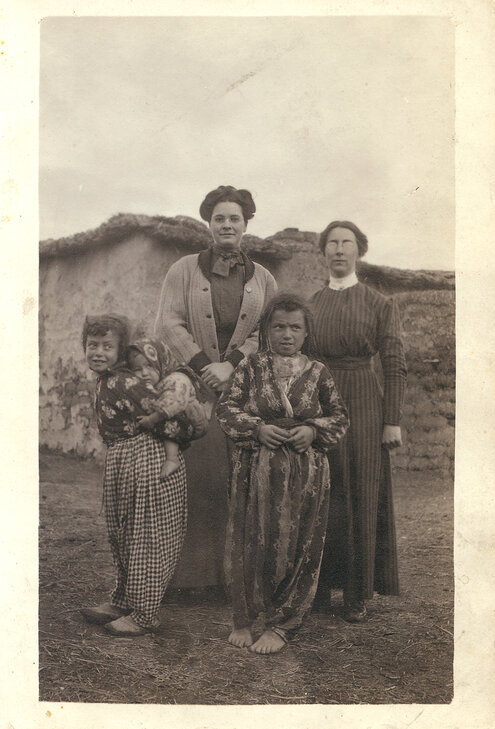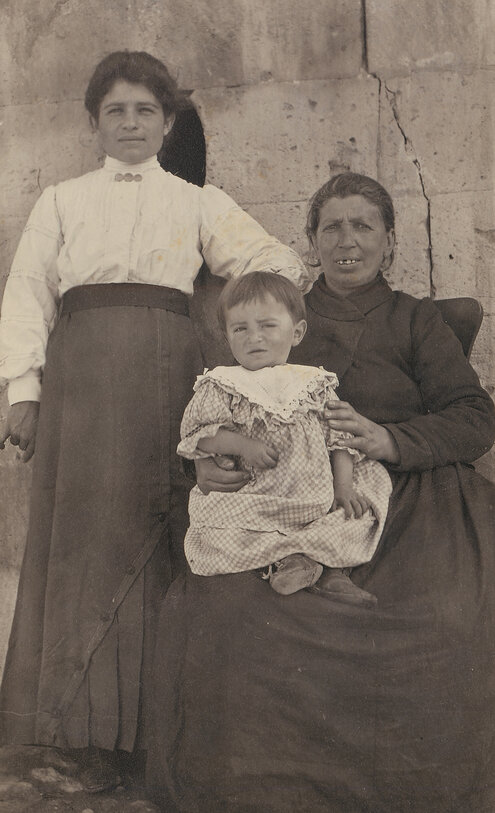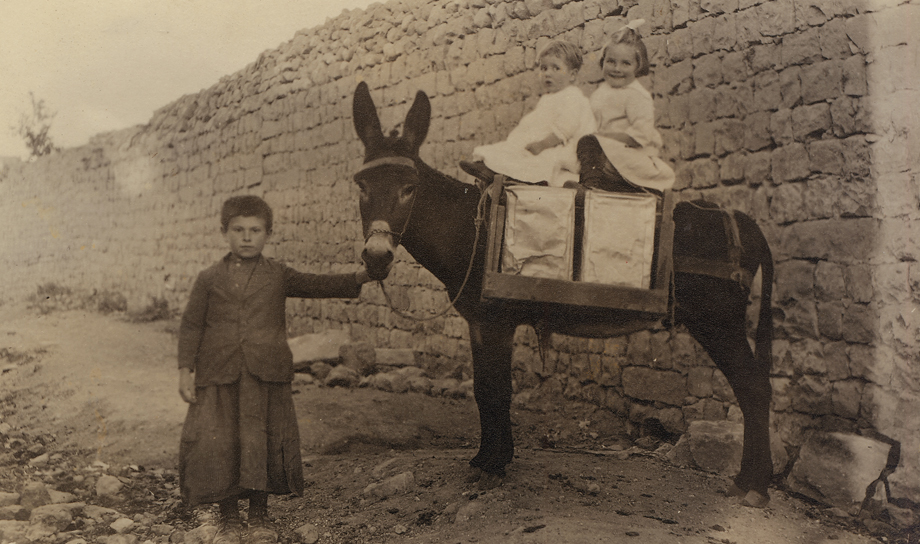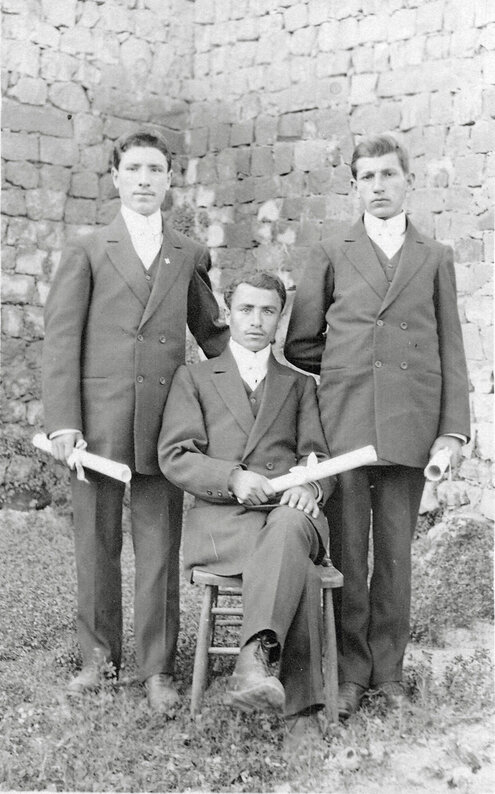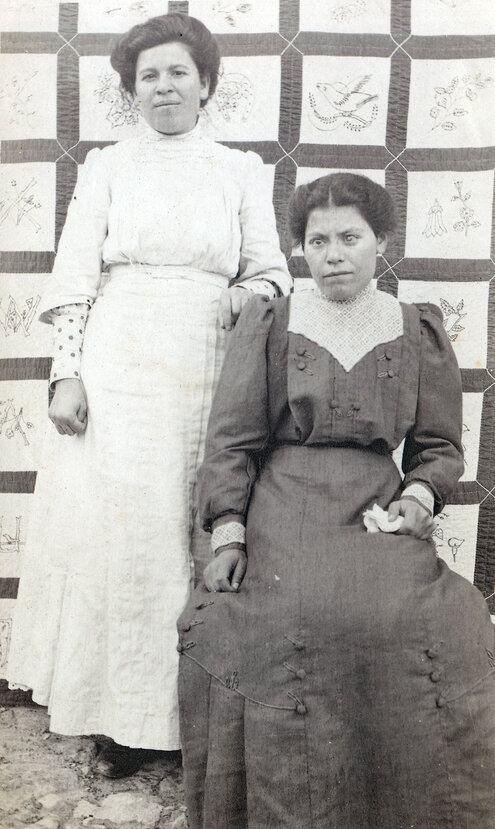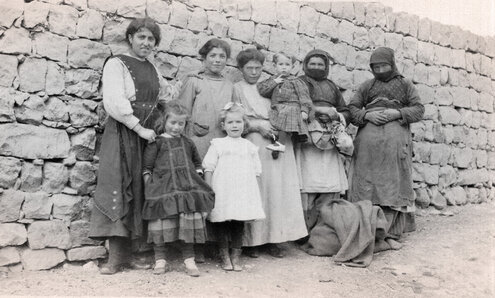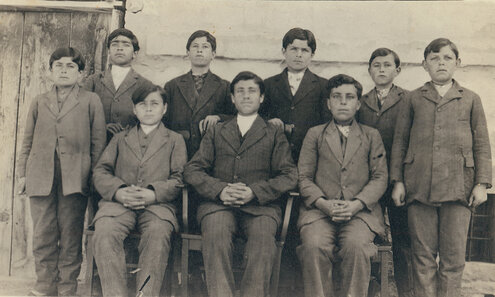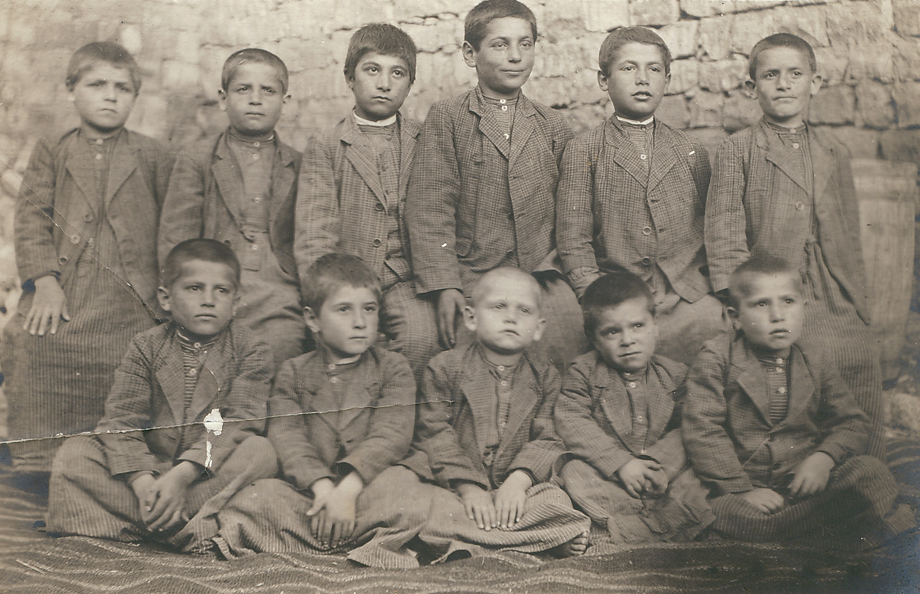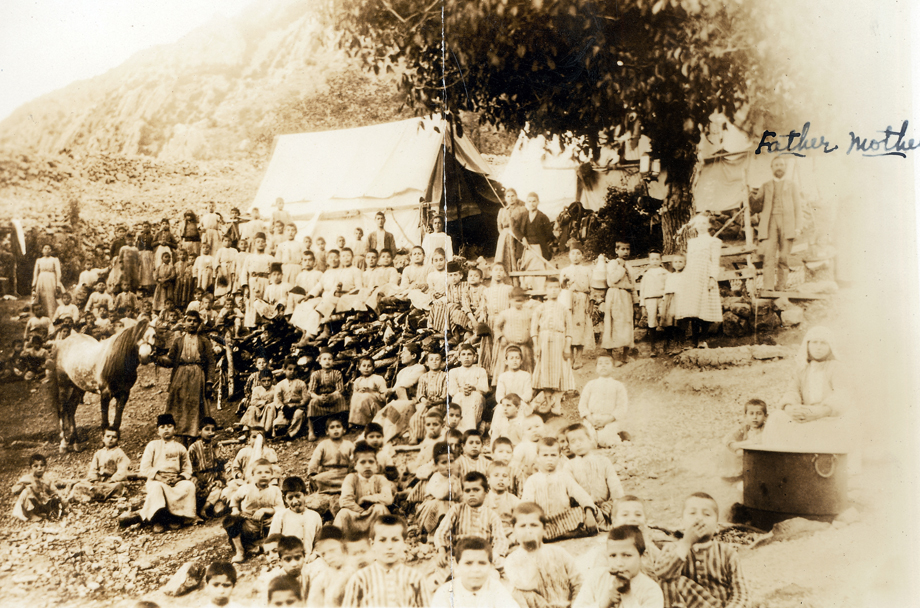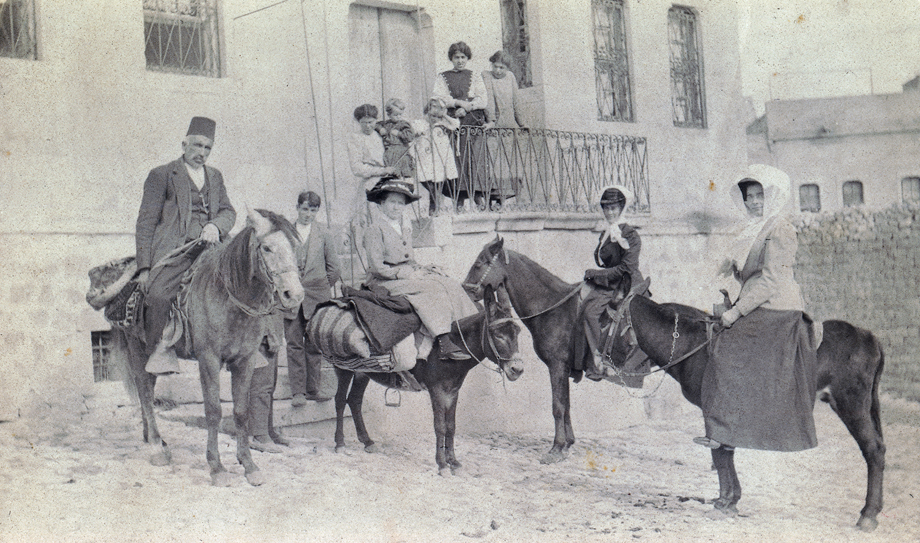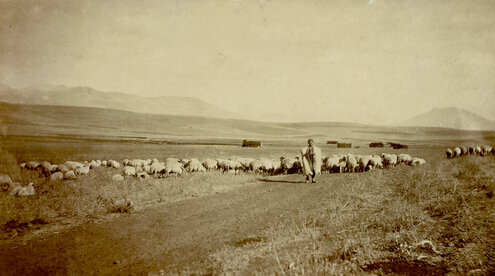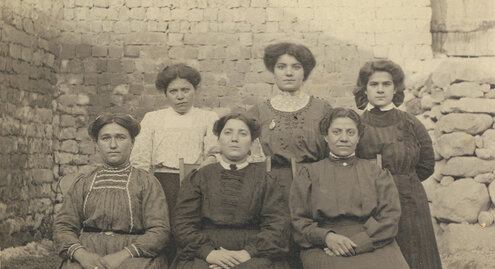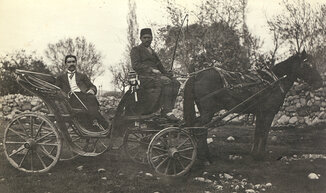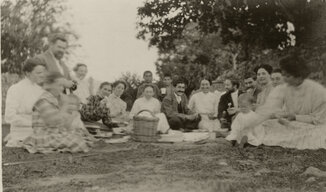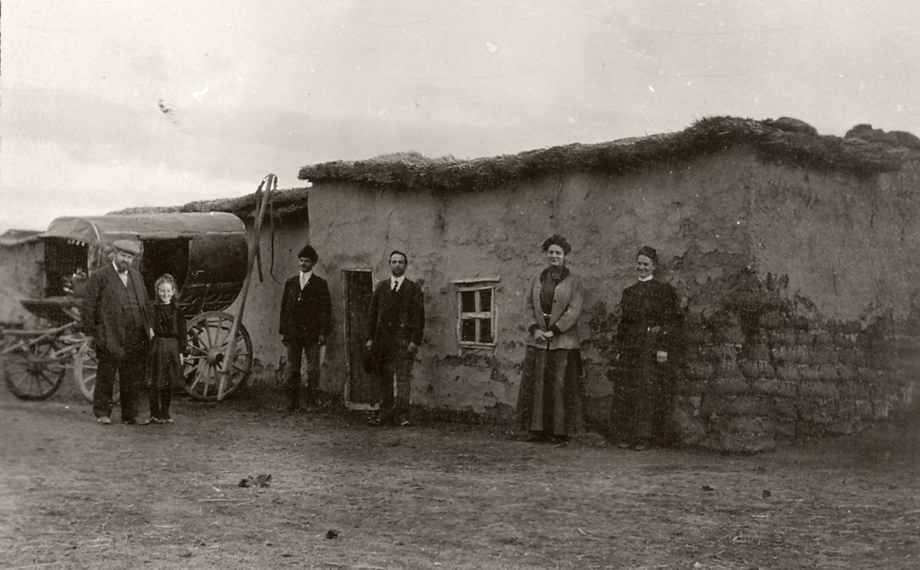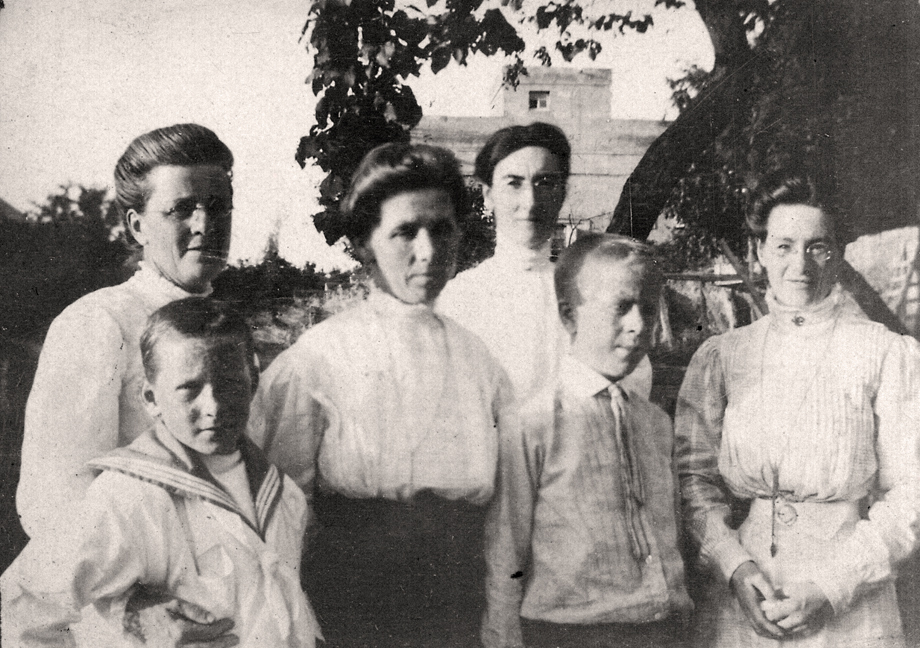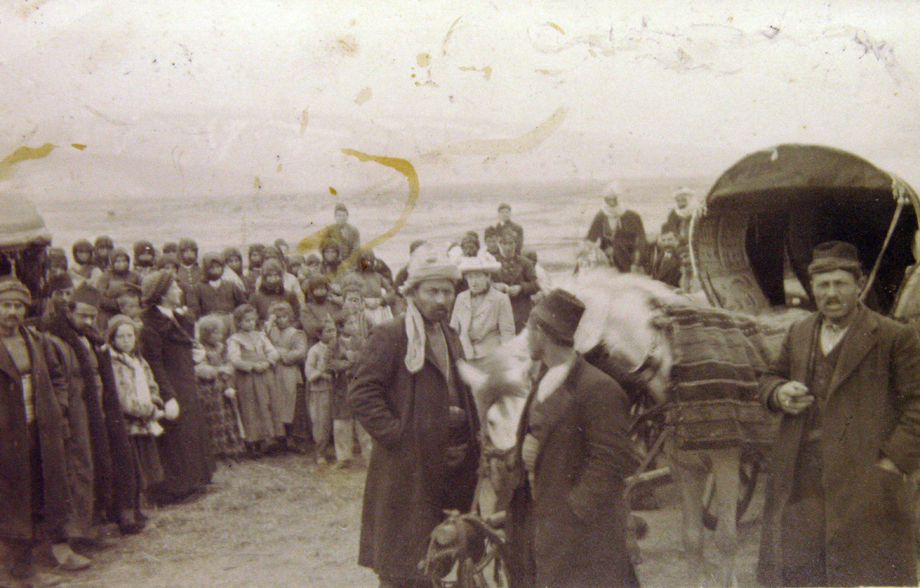Hadjin - Missionaries
Author: Rosemary Russell, 02/05/2016 (Last modified: 02/05/2016)

Introduction
The history of the United Orphanage and Mission (UOM) began in December 1898 when two nurses, Rose Lambert and Maria Gerber, arrived in Hadjin to open an orphanage. The important work they set in motion would continue for over 20 years and include the service of nineteen additional missionaries who helped establish orphanages in Hadjin (1899-1909), Sis (1900) and Everek (1910-1914).
The United orphanage and Mission, formed in 1901 and included missionaries from three denominations: Mennonites, Mennonite Brethren in Christ, and Missionary Church Association (the latter two were offshoots of the Mennonites and merged in 1969 to become the Missionary Church.)
The government closed the station in Sis in autumn 1900 after only six months. The Everek station opened in 1910. At this time, the boys’ orphanage was transferred there from Hadjin. The missionaries started a boys’ school staffed by former orphans and installed Norah Lambert as principal. The start of WWI forced the closing of the Everek and Hadjin stations. Three missionaries returned to Hadjin in 1919. After less than a year, they were forced to leave. The Ebys returned home, but Katherine Bredemus relocated to Cyprus and was there to meet the survivors of Hadjin’s tragic end. She undertook relief work at Lanarca. In letters to supporters, she recorded the stories of those who had survived the several months’ long siege and final massacre.
From 1900 until she left in 1909, Rose Lambert bore the weight of the orphanage work on her young, capable shoulders. What she accomplished as a woman in her twenties is nothing short of remarkable. (She had just turned thirty-one when she left her adopted Armenian home in autumn 1909, frail from typhoid and the strain of April’s calamitous events.)
In Hadjin, the orphans (who had come from Hadjin and neighboring areas) observed strict schedules in the Girls’ and Boys’ Homes. Prayer meetings, meal time, schoolwork and chores shaped their days. Local women taught sewing, knitting, and needlework to the girls. Each year, a group of older girls sat out the school year and helped with cooking and cleaning, as well as the sewing and mending of dresses, underwear and stockings. This arrangement kept the orphanage on its very tight budget and ensured the girls received proper training as homemakers. Their education being equally important, they attended schools run by the American Board, a separate mission whose focus was education.
Just as with the girls, the missionaries, in keeping with the cultural expectations of young men, required each orphan boy to learn a trade. The orphan boys, too, were provided a good education. During the year that he studied weaving or woodworking or some other valuable skill, the orphan did not attend school.
Overseeing the education, discipline and nurturing of nearly three hundred orphans would seem to discount having time or money for the poor. Yet Rose Lambert insisted the mission retain a fund to employ impoverished widows in Hadjin. She hired them to carry water from the fountains to the orphan homes; to spin wool and goat’s hair, and to knit stockings. Even the blind and crippled widows were given the opportunity to earn a few cents to feed their children.
The mission opened a dry goods store, slipper shop, bakery, and weaving factory. These industries provided employment, apprenticing for trades, and income to fund the orphanage. The bakery supplied not only the Boys’ and Girls’ Homes but generously served bread to the hungry.
After Rose Lambert's departure, the mission underwent a number of changes. Even so, orphans, widows, the blind, sick, lame and destitute remained the focus of the missionaries.
United Orphanage and Mission evolved over its two decades in the Ottoman Empire. It faced daunting challenges in an unstable empire and had to respond to massacre, disease, inflation and political unrest. It is not possible to characterize the mission in definitive terms except to say that the missionaries who followed Rose Lambert to Hadjin, and expanded the reach to Sis and Everek, addressed the needs of the Armenians in whatever condition they found them and with whatever means they had available.
Bethel Library collection of photographs from Hadjin
Most of the photographs in this gallery belonged to Dorinda Bowman, a missionary with the United Orphanage and Mission 1909-1938. When she was not in the field, she was back in the United States working as editor for the mission’s newsletter. The photographs selected for this presentation represent the mission work in Hadjin and Everek and do not include her years of relief work in Syria and Lebanon. (Those photographs are available at the Missionary Church Archives, Bethel College, Mishawaka, IN.) The photographs from the Dorinda Bowman Collection number over 200.
The pictures scanned from the Gospel Banner represent the years before Dorinda Bowman’s arrival and constitute those years when Rose Lambert oversaw the mission work in Hadjin. Other photographs came from Everek Storms, son of Mr. and Mrs. D.J. Storms who served in Everek; Marion (Eby) Archer and Ruth (Eby) Maconochie, daughters of D. C. Eby; and Ruth Anne O’Hara, granddaughter of Anna Bowman.
Special thanks to Kevin Blowers Technical Services Librarian and Curator of the Missionary Church archives, Bethel College, Mishawaka, IN.
Hadjin orphans
1) Hadjin, circa 1908. Turfunda and Khatoun. Often, pictures like this one were sent to those who sponsored orphans.
2) Circa 1907. Akabi Ariklian entered the Girls’ Home in 1901. According to the orphanage registry, her widowed mother was poor, having “no house, garden or vineyard."
3) Circa 1913. Dorinda Bowman stands with her arm around an orphan girl who
suffers from trachoma, a contagious eye disease that blinded many in Hadjin.
1) 1920. Kurdish refugees in Hadjin.
2) 1920. Kurdish refugees in Hadjin. Mohammed, on the left, was taken into the orphanage. The Girls’ Home had been burned down, so a mud brick building was erected on the missionary property south of town (on Sourp Sarkis).
3) Circa 1919-1920. This is one example of the many orphans who begged to be taken in when the missionaries returned to Hadjin after the war.
According to the late Richard Bowman of Anderson, Indiana, this was one of three rugs his aunt, missionary Dorinda Bowman, brought back to the United States along with the orphan dress when she left Hadjin on November 6, 1914. The imperfection (most obvious in two corners) bears witness to the missionaries' abrupt departure, precipitated by the start of WWI.
Chaos prevailed in Hadjin during the last half of 1914. The streets were choked with soldiers. Hundreds of Hadjin’s men had been drafted for war. Those who resisted were shot. At the expense of civilians, the army requisitioned horses and food. In response to mounting tensions, the British Consul requested that the missionaries withdraw to Adana. They declined, not being willing to abandon the orphans. Finally, a telegram came from the United Orphanage and Mission Board recalling Dorinda Bowman, Katherine Bredemus and the Ebys. They had no choice but to comply.
Instead of having a few weeks to close down the orphanage, they were given twenty-four hours to pack up and say goodbye. At that point, all of the girls who had relatives had already been sent to them, and those with no family remained in the Girls’ Home. It was they who, under instructions by Bowman, quickly finished the last edge of the rug on their loom so that she could take it and the orphan dress with her. Because she had been in the Boys’ Home during the 1909 siege, she knew what the Armenians feared most, a wholesale massacre. Thus, she took with her the three rugs woven by orphans and a dress worn and clumsily adorned by the girls whom she loved and hoped to see again.
1) 1909. Anna Bowman with orphans in Hadjin. The boys have just received treatment for an eye ailment, probably trauchoma, which was a common and devastating eye infection.
2) Circa 1909. In front from left: Levon, Bedros, Mardiros. Seated behind from left: Hovsep, Avedis, Vartevar, Mardiros. A group of orphans at the boys' vineyard. The younger boys are standing behind this group of older orphans.
Circa 1912. This is probably last group of boys and girls from the United Orphanage and Mission who graduated from the Hadjin Home and the Boys' Academy. From left back row: Khatoun, Manoug, Sultan, Mampre. Middle row from left: Yeranos, Lucia, Asdour, Miram. Front row from left: Osanna, Hovsep, Azad.
1) Orphans from the Girls' Home in Hadjin combing one another's hair. Summers in the vineyard provided a welcome respite from the rigors of school and a break from the sultry weather in town.
2) Circa 1913. These are children of the orphanage staff at the mission's vineyard. Three of them are holding puppies.
3) Circa 1913. Children of the mission's staff pose for a picture on a carefree day at the vineyard.
4) Circa 1913. These are children of the orphanage staff at the missionary home on Sourp Sarkis.
Circa 1910. Hadjin. A group of orphans from the Girls' Home. 3rd row (from left): Haiganoush (teacher), Teberik, Vartina, Khatoun, Turfanda, , Miriam, Yeghsapet, Gyulezar (teacher); 2nd row, seated (from left): Shaksena, Lousaper (teacher), Khatoun, Osanna, Soultan, Hripsime, Miss Tchumi (Missionary nurse), Sara; 1st row, seated on the ground (from left): Hripsime, Akabi, Hripsime, Sofia, Miriam, Suzi, Khatoun, Osanna, Martha, Osanna, Miriam. (The teachers at the Girls’ Home oversaw sewing, cooking and cleaning.)
1913. Each year a group of orphan girls sat out of school to cook, clean, and sew for the orphanage. In this way, they earned tuition to attend the Hadjin Home School of the American Board, learned to run a household and helped maintain the Girls' Home. Besides those orphans featured in this photograph, are the missionaries, members of the staff and their children. Gyulezar (back row third from left); Gasia Hanum (back row fifth from left); Katherine Bredemus (seated far left) Aigul (seated center front); Dorinda Bowman (seated far right); Sulitsa, daughter of Gasia Hanum (small girl in front on right); Rebecca, daughter of vineyard cook (small girl in front on left). Aigul, the woman in charge of sewing, was the widow of Harutune Usta, killed in Hadjin during the 1909 siege while bravely carrying messages to and from the telegraph office.
Dorinda Bowman brought this orphan dress from Hadjin along with the orphan rug when she and the other UOM missionaries left in November 1914, after the start of WWI. The dress was made either by a woman employed at the orphanage or by an orphan girl herself. The front view (left) shows the many patches and mended tears stitched by orphan girls. A view of the backside (right) reveals the typical striped pattern of the fabric. Rosemary Russell discovered this dress and other mementos of Bowman's years as a missionary during a visit to the Missionary Church Archives at Bethel College in Mishawaka, Indiana, USA.
1) Circa 1907. A group of orphan boys in Hadjin. This picture may have been taken to find sponsors during a famine in the region.
2) The school for the blind in Hadjin ran for three years (1912-1914). Gyulvart, (back row second from left), taught the students practical skills, such as weaving reed mats or seats for low stools; Dorinda Bowman (third from left); Yeghsapet Barokyan taught reading, writing and math (back row far right). This school was funded by supporters in Switzerland and England.
These women made up the staff at the American Board's Hadjin Home 1912-1913, the school's final year. Back row center: Olive Vaughan, missionary with the American Board. To her left is Mary. Seated in the middle row second from left : Osanna Hanum, matron of the school and widow of Badveli Garabed Kyupelian, pastor of the Protestant church in Osmaniye who was massacred in 1909; Mariam Hagopian; Edith Cold, missionary with the American Board; Leah Partsoumian; Marta. (Mary, Leah and Marta were orphans from the Girls’ Home.)
Circa 1910. In back, Norah Lambert (L) and Dorinda Bowman (R). Armenian staff include: Gyulezar (standing far left); Haiganoush (white blouse with design on front); Lousaper (seated center in chair). This group of orphan girls sat out this school year to sew, cook and clean in the Girls’ Home and thereby earn tuition to attend the Hadjin Home run by the American Board missionaries.
Hadjin. American Board compound. 1913. Seated center is Norah Lambert. Standing behind her are Blanche and D.C. Eby. The UOM occupied the missionary residence at the American Board compound east of town when the American Board recalled its missionaries, Olive Vaughan and Edith Cold. Included in this photograph are the orphan girls who worked as cooks and seamstresses and the women who made up the teaching staff for that school year. From left, seated: Gyuluzar, Mary, Khatoun, Norah Lambert, Khatoun, Miriam, Haiganoush. All (except N. Lambert) former orphans now staff for the 1913-1914 academic year.

Hadjin: Views from the town
Circa 1909. This photograph looks northwest toward Middle and Upper Hadjin. In the lower left is St. Asdavadzazin, a girls' school, the Boys' Academy (only upper two stories visible) and the Catholic church (marked by the cupola). In the lower right is a stream. In Upper Hadjin is the Girls' Home (1899-1914), the tallest multi-story building on the right; the large white building left of the Girls' Home is the First Church, owned by the American Board but run and supported by a local congregation; The Boys' Home (1898-1910) is straight down from the First Church and is distinguished by the inset roof line. The town's business district lay in the area between Boys' Home and the Boys’ Academy. Rose Lambert arrived in Hadjin in wintertime and thought it dull and ugly. It was not until spring that she learned why Hadjinstis considered their home a paradise. Lambert often road her horse to a beautiful spring on this side of town, called Krdet. (Photograph by Dorinda Bowman)
1) This is a traveler's first view of Hadjin when entering from the direction of Adana. (Two other roads came through Hadjin as well: north from Caesarea and east from Marash.) Two government buildings greet guests and returning residents. The white, gabled structure above the second government building is likely one of the primary schools in Lower Hadjin that was run by the American Board and staffed in part by graduates of the Hadjin Home, the girls' school east of town. Just above the school, from right to left, is St. Asdavadzazin and an Armenian Apostolic girls' school. Not visible at this angle are the Boys' Academy and the Catholic church. The white four-story building on the bluff is the Catholic school. Further left you catch a glimpse of Upper Hadjin expanding northward up the mountain.
2) Circa 1912. Laundry day in Hadjin. The water is brought up by women and children from one of the fountains. As can be observed in front of several houses, the wash hangs to dry in the sun. The used water is recycled to wash floors and to clean outhouses, where they exist.
1) Circa 1909. This photograph appeared in Hadjin and the Armenian Massacres by Rose Lambert (1911). Isabelle was called a Bible Woman. She visited Hadjinstis in their homes. She would pray with them, teach them about the Bible, and let the misisonaries know the conditions and needs of those whom she visited.
2) Circa 1912. UOM Missionary home on Sourp Sarkis with vineyards on either side of the house and a temporary vineyard home for staff in the foreground (far right).
3) Nov 30, 1913. From left: Member of orphanage staff; Turk standing beside packhorse; Turkish gendarme; Norah Lambert; Katherine Bredemus; D.C. Eby. The group is passing through the gorge of the Seyhan River en route to Feke from Hadjin. Photograph taken by Blanche Eby.
This is the American Board compound, about a 15-minute walk east of Upper Hadjin. The building in the back was called the First Church Parsonage. The one-story building on the left housed classrooms. The building behind it also had classrooms and was the dormitory for those girls boarding here and the residence of the American Board's female missionaries. The third in this row of buildings served as a missionary residence. Mr. Martin and his family lived here 1899-1906; Mr. and Mrs. Gardner 1909-1912. The compound served in a number of other capacities as needs arose. For a time, a small group of boys came here for school until the academy opened in 1893. In the aftermath of the 1895 massacres, some orphans girls were brought here (and a boys' home opened in town). Primarily, the premises served as the site of Hadjin Home, a secondary school with both day students and boarders. In 1920, missionaries, relief workers, orphanage staff and orphans took refuge here for ten weeks before the property was evacuated.(Photograph by M. Andonian)
1) Circa 1909. This is a view of Hadjin from the east that includes the tops of the mountains that marked the city limits to the west. In the foreground is the American Board compound. Beyond that is the western edge of town and a glimpse of a few buildings on the famous outcropping. In the distance (center left) is St. Hagop Monastery. This perspective makes clear the degree to which Hadjin enjoyed the natural protection of soaring peaks but also its vulnerability to encirclement.
2) 1913. On the way from Mersine to Everek. Photograph taken by D.J. Storms.
1) This is a view of Hadjin from the east. The American Board compound is in the foreground. The road leading out of town to this property is the undulating path wrapping around the mountain, about a fifteen minute walk. Middle Hadjin is the section of the city stretching from north to south (right to left). St. Asdavadzazin is just outside the frame to the left. The tall white building far left is the rear of the Boys' Academy. Further to the right is the blurry cupola of the Catholic church. To the right of the church is another tall white building, the Catholic school. The wall of mountain in the background marks the western limits of town. At the base of the mountain to the left is the barracks that housed about 500 soldiers. To the right is St. Hagop Monastery. This mountain, at the time of this photograph, was the site of many summer vineyard homes. Upper Hadjin is just around the sloping mountain if you follow the path from the missionary compound.
2) Circa 1905. This photograph is taken above the barracks on the west side of town. North of this location (left) is St. Hagop Monastery. At the time of this photograph, 500 hundred Turkish soldiers and 59 officers are stationed in Hadjin. The American Board compound is straight across on the mountainside east of town. Only a portion of Upper Hadjin is visible from this perspective (middle left). The iconic St. Asdavadzazin is at the southern tip of the outcropping. The trees in front of the barracks and those seen rounding the southern edge of town mark the steep drop to the rivers that cut through this valley and encompass the town. The unique geography of Hadjin led one visitor to describe it as being built on a spur of rock.
This distant view captures the entire town in one photograph. Lower, Middle and Upper Hadjin are visible. What is not apparent is the lush foliage and the gardens cultivated along the two rivers that encircled the town; nor is there any sign of the mills powered by their strong currents. Hadjin was reached from the Adana Plain after four days' travel through the Taurus Mountains, yet the city sat approx. 1,000 meters (3,500 ft) above sea level. The barren peaks encompassing the town jutted up over 3,000 meters (10,000 ft). When missionaries explained Hadjin, they likened its hundreds of houses to birds' nests clinging to the side of a mountain, or as looking like a honeycomb. On the bottom lower right is the government building (1) that housed dignitaries and the telegraph. The iconic St. Asdavadzazin Church (2) stands at the south end of the bluff (Middle Hadjin). To the left of the Armenian church is the girls’ school (3). Further left is the top story of the Boys' Academy (4), the St. Mary’s Catholic Church (5) and the Catholic school (6). Visible in Upper Hadjin are the Boys' Home (7), the Girls' Home (8) and the American Board's First Church of Hadjin (9). The American Board missionary compound (10) is the cluster of buildings to the far right (east of town).
1) 1909. En route to Hadjin via Adana. Dorinda Bowman stops to photograph the caravan transporting her and another new missionary (distant cousin Anna Bowman) to Hadjin.
2) Circa 1911. Dorinda Bowman photographs this view of Hadjin from her tent in a vineyard high above the city extending south (R) and east (L) down the mountain. To the south is the famous outcropping at the end of which sits Sourp Asdavadzazin Church. Across from the church is a white building, which is the new missionary home (and the former boys' vineyard). The Girls' Home in Upper Hadjin is the second white building as city slopes eastward (L). At this point in time, the Boys' Home had been vacated.

Missionary stations in Hadjin
1) 1914. Workmen rebuilding the missionary home on Sourp Sarkis stop to pose with missionaries D.C. Eby, Dorinda Bowman, Norah Lambert, Blanche Eby and Magdalena Didszun (nurse from Germany).
2) Winter 1913. Blanche Eby (L) and Norah Lambert (R) outside the missionary residence on the American Board compound. The Hadjin Home had closed, and the missionaries, Olive Vaughan and Edith Cold, were on furlough. The UOM missionaries looked after the property in their absence.
Hadjin, 1905. In 1899, the government prevented Rose Lambert and Maria Gerber from opening an orphanage in J.C. Martin’s newly built home on the American Board compound. Hampartsoum Agha Redjebian intervened, and the women were permitted to move into this house, which the United Orphanage and Mission eventually purchased. It served as the Girls' Home until 1914 when the missionaries were recalled at the start of WWI.
1) 1913. From left: Dorinda Bowman, Katherine Bredemus, D.C. Eby, Blanche Eby. Orphans and staff members in the background. All have gathered to survey the ruins of the missionary home after a devastating fire.
2) August 1913. Blanche and D.C. Eby moved to this typical vineyard shelter after the fire destroyed the missionary home that had been completed in 1912.
1) 1913. Children of the orphanage staff pose with Dorinda Bowman on a summer's day in the vineyard on Sourp Sarkis. Orphan girls are standing on the left.
2) Circa 1911. Mourad, former orphan and a member of the orphanage staff, his wife, their three children and a group of young orphan boys pose for a picture at Mourad's summer home on Sourp Sarkis near the missionaries’ new home.
1) 1914. D.C. Eby poses with the workers who are rebuilding the missionary home that burned the previous year.
2) 1908. From left: Ida Tschumi, Fredericka Honk, Henry Maurer, Rose Lambert and George Lambert visit the fresh grave of Dr. Elizabeth Hawley Maurer. The grave next to Ida Tschumi belongs to Adeline Brunk who died in 1906. Behind George Lambert are the graves of the Martins’ baby and Miss Spencer (of the American Board). The missionary cemetery adjoined the Protestant cemetery on the north side of town.
3) Circa 1909. On the far right is Harry who was taken into the Boys' Home in 1906. He is playing here among the grapevines at the vineyard.

Missionary biographies include everyone who worked in Hadjin, Sis and/or Everek
Rose Lambert (1878-1974) came to Hadjin as Maria Gerber’s assistant in 1898. She bore the title Matron of the Girls’ Home and became the face of the United Orphanage and Mission. Often the only medical personnel in a city of 20,000, she paid housecalls to the destitute. She budgeted her funds so she could employ widows while also caring for orphans. Her courage during the siege of 1909 earned her a letter from the Patriarchate in Constantinople—the first received by a missionary up to that time. She left Hadjin in the autumn of 1909 in poor health. She never regained the strength to return, but others carried on her work.
Maria Gerber (1858-1917) opened orphanages in Hadjin and Sis 1898-1900. She had trained Rose Lambert as a nurse. They worked at the Deaconess Hospital in Cleveland, Ohio, until going to Turkey to care for orphans. (Gerber founded the Zion Orphanage at Zinjidere.)
Ada Moyer Barker (1875-1982) worked in Hadjin, Sis, and Everek, 1900-1914. She married T. Ford Barker. Rose Lambert praised her friend, saying, “She understood the Armenians.”
Fredericka Honk (1876-1909) worked in Hadjin and Sis from 1900 until her death on May 30, 1909. Like so many others in Hadjin that year, she succumbed to typhoid.
J.E. Fidler (1868-1936) served as superintendent of UOM 1900-1903. His wife Elizabeth and their youngest child, Bertha, came with him to Hadjin (leaving the three older children in the United States). Bertha carried on relief work with UOM in Syria and Lebanon 1925-1930.
T. Ford Barker (1874-1944) oversaw the Boys’ Home in Hadjin and then in Everek. He arrived in Hadjin in 1901 and served as superintendent of UOM 1903-1914. He married Ada Moyer.
Helen Penner came to Hadjin in 1905. She left in 1906 in poor health. She traveled throughout Europe, the United States and Asia on behalf of the mission through 1912.
Ida Tschumi (1872-1960) was a nurse who came to replace Rose Lambert during her furlough. Tschumi remained with the orphanage for several years, 1905-1912.
Adeline Brunk (1872-1906) came to Hadjin in 1906 with Rose Lambert who was returning from furlough. Brunk contracted typhoid a few weeks later. She died Dec 11, 1906.
Henry Maurer arrived in Hadjin late 1906. He married Dr. Elizabeth Hawley in 1907. He was killed in Adana Apr 15, 1909.
Dr. Elizabeth Hawley Maurer (1871-1908) joined the ABCFM (American Board) in Turkey in 1904 and worked in Hadjin 1906-1908. She married Henry Maurer in 1907. While caring for Fredericka Honk, she contracted typhoid. She died Sept 21, 1908.
Dorinda Bowman (1880-1966) came to Hadjin with her cousin Anna in 1909, just six weeks before the Adana Massacres. It was she who brought out the orphan dress and rug when the missionaries left Hadjin in 1914. She participated in relief work in Syria and Lebanon 1923-1931.
Anna Bowman, cousin of Dorinda Bowman, worked for the UOM in Hadjin 1909-1914.
Norah Lambert Sommers (1887-1947) was the younger sister of Rose Lambert. She worked for UOM 1909-1914 in Hadjin and Everek.
Ethel Nelson joined the UOM in 1909. She worked in Hadjin and Everek until 1912.
Katherine Bredemus served in Hadjin and Everek 1909-1914. She returned to Hadjin 1919-1920. After the massacre at Hadjin, she undertook relief work on Cyprus 1920-1924.
Daniel C. (1885-1981) and Blanche Eby (1885-1925) served in Hadjin 1910-1914; 1919-1920. They returned as relief workers in Syria in 1923. Blanche wrote At the Mercy of Turkish Brigands. After Blanche’s death, D.C. remarried and continued work with the UOM until it closed in 1938.
D.J. and Mrs. Storms joined the UOM at Everek 1913-1914. They had a son while there, Everek R. Storms.
Honk, Brunk, the Maurers and Mrs. Eby gave their lives in service to the Armenians, on foreign soil where they toiled and were buried far away from their homes.
1) Circa 1911. Ethel Nelson (L) and Anna Bowman (R) on the porch of the new missionary home at Sourp Sarkis (the spur of rock south of Hadjin). Photograph by Dorinda Bowman.
2) Circa 1911. From left: Ethel Nelson, Dorinda Bowman, and Anna Bowman. The women are enjoying a day at the new missionary home on Sourp Sarkis (the spur of rock south of Hadjin).
3) Circa 1911. Anna Bowman (L) and her distant cousin, Dorinda Bowman (R), sitting on the porch at the new missionary home.
1) Circa 1905. UOM Missionaries and their staff in Hadjin. Back row from left: Neshan, Sarkis Devyan, Hamparstum, Arshag Balian, Avedis Keshishian; Third row from left: Nouritsa Levonian, Srpouhi Boulghourdjian, T.F. Barker, Ada Moyer Barker, Osannah Topalian; Second row from left: Rose Lambert, Fredericka Honk, Ida Tschumi, Helen Penner; Front row from left: Gasia Tenekedjian, Helen, Srpouhi Boyadjian, Soultan Baradjikian, and Nouritsa.
2) May 8, 1913. Taken inside their new home on Sourp Sarkis. From left back row: D.C. Eby, Blanche Eby, Ada (Moyer) Barker, T.F. Barker. Front row from left: Katherine Bredemus, Ruth Barker, Dorinda Bowman.
3) February 1909. From left: Henry Maurer, Anna Bowman and Turkish soldier, a mandatory companion for travel in the Empire. Maurer is escorting new missionaries, Anna Bowman and Dorinda Bowman (the one taking the photograph), from Adana to Hadjin.
4) 1913. A group of children from the orphanage staff pose for a photograph at the missionaries’ home in the vineyard on Sourp Sarkis.
5) Rev. Henry Maurer returns from Adana to Hadjin with two new missionaries, Anna Bowman (far right) and Dorinda Bowman (taking picture) in February 1909.
6) 1910. From left: Ethel Nelson, Mutaber Hanum (widow of former Sis pastor killed in 1909 massacre), Lousaper (sewing teacher at the orphanage), Ida Tschumi, Norah Lambert. The women have gathered outside Tschumi’s tent up in the mountains where they stayed during the summer.
Winter 1913/1914. From left: Katherine Bredemus, Magdalena Didszun (nurse from Germany), Dorinda Bowman, Norah Lambert, Blanche Eby and D.C. Eby. Taken at the American Board property. (Lambert and the Ebys moved into the American Board missionary home to care for the property after Olive Vaughan and Edith Cold left on furlough.)
1) May 8, 1913. Taken inside the new missionary home on Sourp Sarkis. From left back row: T.F. Barker, Katherine Bredemus, Dorinda Bowman, D.C. Eby. From left front row: Ada (Moyer) Barker, Ruth Barker, Blanche Eby.
2) From left back row: T.F. Barker, Katherine Bredemus, Norah Lambert, Ethel Nelson, D.C. Eby. From left front row: Ida Tschumi, Ada Moyer Barker holding Evangeline, Blanche Eby, Dorinda Bowman. In front, Ruth Barker (L) and Anna Bowman (R). These were the missionaries with United Orphanage and Mission in Hadjin in spring 1910.

The orphanage staff in Hadjin
1) Circa 1910. Mourad Khodja (L) and Mihran Khodja (R), staff members at the Boys’ Home in Hadjin.
2) Circa 1909. Gyuregh (L), nightwatch at the Boys’ Home and Armenag (R), one of the older orphan boys. Dorinda Bowman took this photograph at the old vineyard house west of town.
3) Circa 1911. Dr. A. Philippidis, Hadjin’s physician. (Dorinda Bowman took this photograph at the new missionary home on Sourp Sarkis.)
Circa 1913. From left back row: Khatoun, Sara, Azad, Gasia, Gyuluzar, Sultan. From left front row: Aigyul (sewing teacher and widow of Haroutyun Ousta who was killed delivering a telegram during the 1909 siege), Sultan Bodgy, Khatoun, Minas Efendi Mutafian. These were members of the staff at the Girls’ Home. (Minas Ef. died protecting the orphan girls when Kemalists forces massacred Hadjin’s inhabitants in 1920.)
1) Circa 1910. From left: A woman who cared for one of the orphan boys in quarantine; Sara Bodgy, cook for boys’ orphanage; woman who used to care for sick orphan boys; Nouritsa, the missionaries’ cook at the Boys’ Home.
2) Circa 1913. Pine clippings from felled timber are stored in the small windowless building on the missionaries’ property. These clippings will be dried and used in the fireplace to heat their home.

Hadjin: Miscellaneous
1) April 1909. This soldier was detached to protect the UOM missionaries at the Boys' Home.
2) Circa 1908. This is a widow and her children in Hadjin. Rose Lambert employed as many of these women as she could afford to.
3) Circa 1911. This is a poor, crippled man in Hadjin. He has a crutch under his left arm, and he is holding a cane with his right. This picture was taken to remind supporters of the many needs before the missionaries and to encourage continued generous financial support.
1) Circa 1905. A shoemaker shop with shoemakers and their apprentices from the Boys' Home.
2) Circa 1909. Armenian women come hoping for work at the orphanage. If funds are available, they will be paid to spin wool, carry water and sew.
3) Circa 1909. This photograph appeared in Hadjin and the Armenian Massacres by Rose Lambert (1911). Lambert was as committed to aiding the widows in Hadjin as she was to helping the orphans.
1) April 1909 at the missionary vineyard west of town. Officer Lutfi Bey led these men to the rescue of Hadjin with the promise of looting the town. Hadjin was rescued but the order to plunder was never given.
2) Circa 1912. From left: Dorinda Bowman and Katherine Bredemus on horseback. The missionaries visiting the site of the new missionary home being built on Sourp Sarkis south of town. This photograph is called a double exposure. The film was not advanced between the first and second photographs. The men in the picture are employed by the UOM.
Everek (present-day Develi): The UOM other station
1) 1913. Norah Lambert (left) and Anna Storms (right) with three Turkish girls. The khan where they stayed is in the background. This Turkish village was approximately 20 miles from Everek.
2) Circa 1913. Everek. Armenian mother, child, and the child’s nurse. This may be one of the young widows of the 1909 massacres employed by the UOM in Everek.
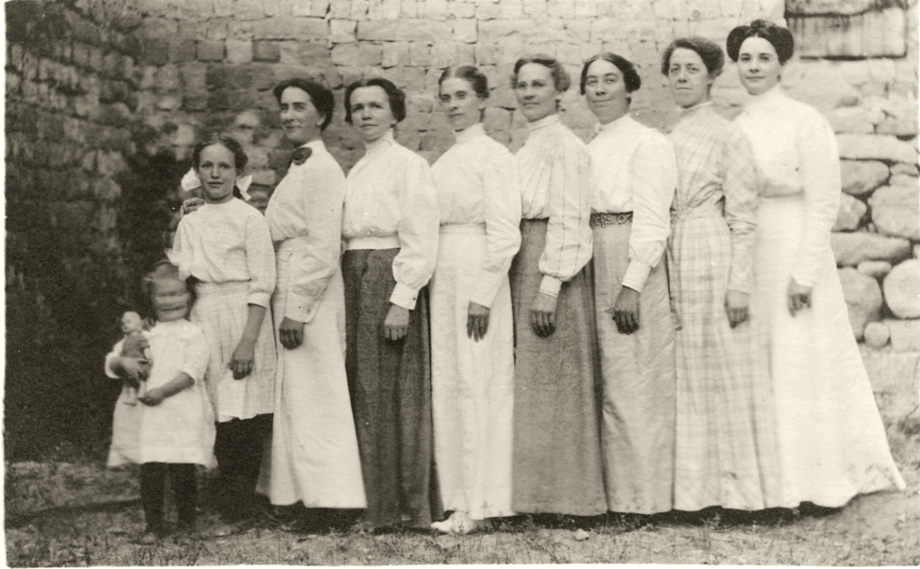
August 1913. Everek. From left: Evangeline Barker, Ruth Barker, Anna Storms, Ada (Moyer) Barker, Katherine Bredemus, Anna Bowman, Blanche Eby, Dorinda Bowman, Norah Lambert. The women and girls of the UOM assemble for a group photograph during their annual meeting.
1) Circa 1913. Three orphan girls likely from Hadjin orphanage are caring for the Barker children, Evangeline in the white dress and Theo being held. Identity of little girl on far left is unknown. The two women on the far right were probably employed by the orphanage in Everek.
2) Everek, circa 1913. This group of school boys is scrubbed, combed and dressed in their suits for a photograph to send to supporters.
Everek, 1914. On the verandah are three older orphan girls from Hadjin with the Barker children. From left in the foreground: an employee of orphanage in Everek; an orphan boy; Magdalena Didszun; Anna Bowman and Norah Lambert. The photograph commemorates the return of Norah Lambert to the Everek after several months' stay in Hadjin to help with the orphanage there.
1) Near the village of Shar. 1909. Harold J. Gardner, a missionary with the American Board, took this photograph during a trip to outlying villages. Gardner ran the Boys' Academy in Hadjin 1909-1912.
2) Everek, circa 1913. These are members of the staff at the boys orphanage and school in Everek.
1) 1913. An Armenian dignitary enjoying the pleasure of a ride in his French-made Victoria.
2) Everek, 1913. From left: Ruth Barker, Ada (Moyer) Barker, T.F. Barker, Evangeline Barker, Anna Bowman, Katherine Bredemus, Dorinda Bowman, Blanche Eby, D.J. Storms, D,C. Eby, Norah Lambert. Theodore Barker small child in foreground on right. The missionaries and staff at Everek are joined by the American staff at Hadjin for the annual meeting. Photograph by Anna Storms.
3) Everek, Circa 1911. A group of orphans from the new boys' orphanage and school in Everek.
1) 1913. From left to right Mr. Barker, Ruth Barker, Mardiros, a former orphan and now teacher at the Boys' Home in Everek, D.J. Storms, Norah Lambert and Anna Bowman standing in front of the khan where they stayed.
2) 1908. Talas, Caesarea/Kayseri. From left in back: Mrs. Wilson F. Dodd, Miss North, From left in front: The youngest child of the Dodds', Ida Tschumi, Stuart Dodd, and Miss Matheson (British nurse). Ida Tschumi with members of the American Board and children of Dr. Wilson F. Dodd who worked at the American hospital in Talas. Hadjin orphans in dire need of medical attention were transported here. However, the purpose of this trip was a visit, not an emergency.

